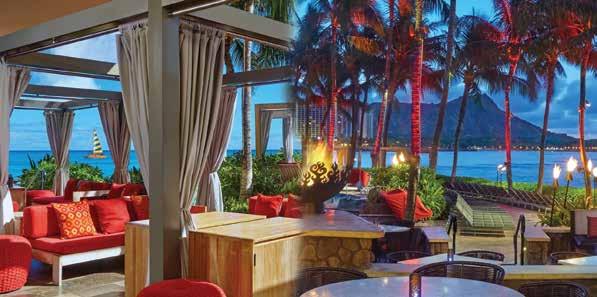


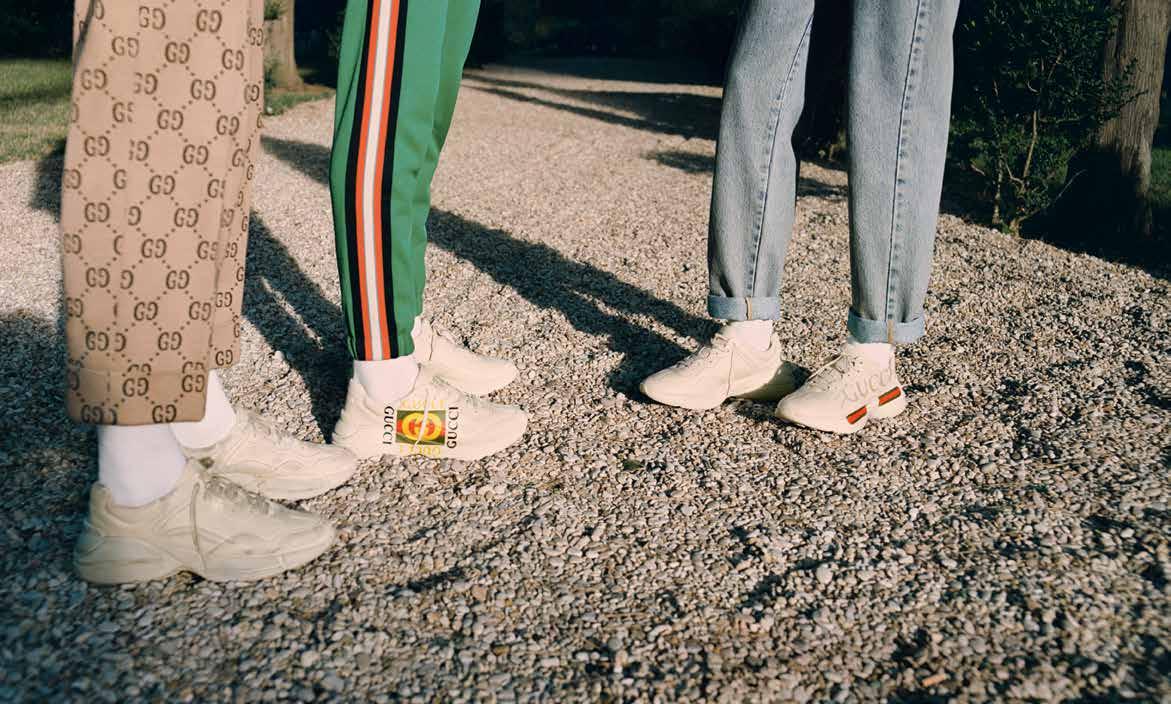









AN UP-FOR-ANYTHING MENTALITY PERMEATES ISLAND CULTURE. Adventure is always a priority: swimming, hiking, exploring, and photographing the ‘aina (land) ultimately leads to a deeper understanding of place — an irreplaceable knowledge that echoes through the rhythms of everyday life. O‘ahu – Hawai‘i

Editor’s Letter
Contributors
FLUX PHILES
20 | Culture: Kaʻiulani Murphy
26 | Art: Matthew Kaopio
A HUI HOU
192 | Transit to Totality

FEATURES
30 | What It Means to Walk
Timothy A. Schuler examines how a seemingly mundane act can transform the world.
44 | A Hula Unearthed
Matthew Dekneef chronicles how an all-male hula hālau enlivens one of the form’s most athletic dances.
58 | The Body Is a Vessel
In this personal essay, Martha Cheng reflects on the strength in self found through surfing and paddling Hawaiʻi waters.
66 | It’s in the Moves
Rae Sojot profiles local residents who are united by motion with this kinetic photo essay.
88 | Synchronicity in Solid Ground
Printmakers Charles Cohan and Abigail Romanchak reveal the creative process behind their collagraphs.

Brought to you by
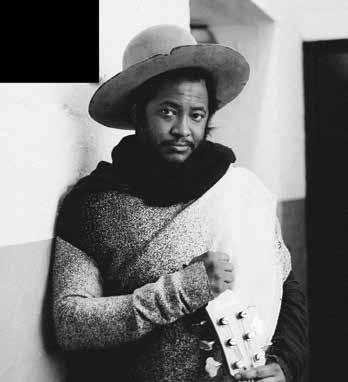
100 | Hawai‘i’s Sonic Exports
Creative Lab Hawai‘i Music Immersive
106 | From the Top Hawaiian Music’s Unique Song Structure
110 | Sounds of Hawai‘i Recording Studios of Yesteryear
116 | Music in the Moment BAMP Project
120 | Ambassadors of Aloha The Green
124 | Underwater Duets Man and Whales
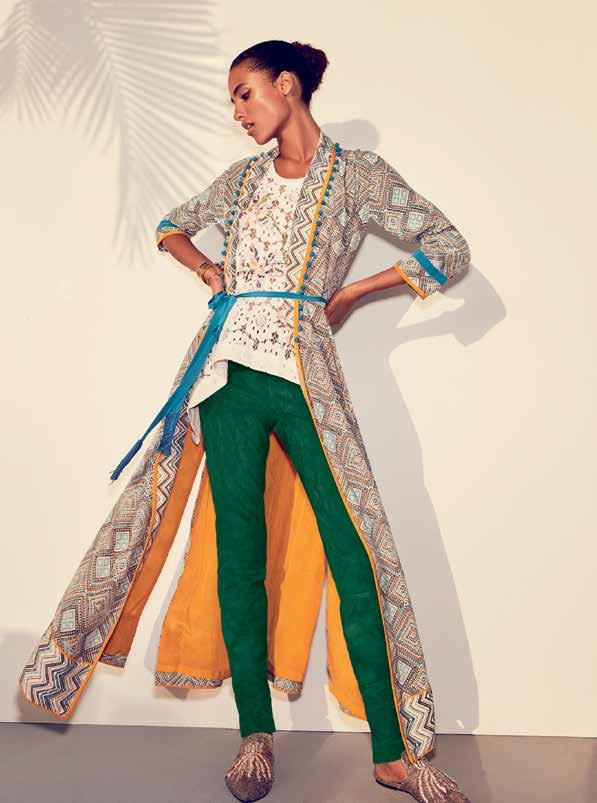
130 | Balance Yancy
136 | Dance Emilia
138 | Dive Benjamin

150 | The Gift of Rain
162 | The Essence of Hawai‘i Contest PhotoCon
178 | Sign of the Times
The World Reflected, Honolulu Museum of Art, Spalding House


“Am I dead?” I ask my acupuncturist, after he informs me of my particularly faint pulse.
It was my third visit in three weeks to his clinic. I sat there awkwardly, with my hand resting on a small pillow on his desk, while he pressed three fingers lightly against my wrist, tilting his head as if straining to hear the soft beat. The pulse, he explained, is like a communication network. Whizzing past major organs and along nervous systems, it is literally “the pulse” on the body’s health and can be used to diagnose ailments or deficiencies.
I had gone to see him on the recommendation of a friend, who spoke wonders of acupuncture’s ability to diminish her pain of a sore ankle. It had been a particularly stressful time for me. Owning your own business has its perks, but it also calls for workdays that stretch late into the night and into weekends. It can result in poor eating habits, scarce physical activity, little personal time with friends and—unhappily, for my still fairly new husband—family.
Athletes like Ryan Leong, who we feature on page 72, talk about “mental toughness,” how putting mind over matter can help the body push through physical pain to cross the finish line. “For any event you want to complete, regardless of whether it’s basic or ultra-endurance, you have to be at peace with the anticipated discomfort, and make the mental decision that you are going to finish, no exceptions,” the triathlete says. “Outwardly, you can say whatever you want, but inwardly, there can’t be an ounce of doubt. Once you’ve come to this mindset, every unexpected obstacle, the suffering, the emotional highs and lows, the desire to just stop moving, can be dealt with because the thought of quitting doesn’t actually exist.”
Acupuncture, I assumed, could work the other way around: settle the mind through the body—specifically, through pricks in my forehead, wrists, stomach, thighs, shins, and the tops of my feet. And it did, to a degree. At each session, the needles were
placed with a quick flick. I scrunched my face to adjust to the needle between my brows, and wiggled my fingers and toes to ease the pressure of needles in nearby extremities. And then I was out cold, waking up dazed, 45 minutes later, to my acupuncturist’s voice.
In the two months that I’ve been receiving acupuncture treatments, and in putting this, our Movement issue, together, I’ve become more aware of how connected the mind and body are. Stress the mind, and the body suffers; treat the body, and the mind can heal. My pulse has improved, according to my acupuncturist. “Whatever you’re doing, keep it up,” he says. Work remains taxing, and I still forget some days to eat lunch. Exercise involves taking the dog out to do his business. Reclining in a lounger once a week with needles in my face is what I’m doing. I’m a work in progress. Another thing that can soothe the mind, and also help get the body moving, is music. And so, it is with much excitement that we announce the launch of FLUX Sound, a new concept event that spotlights Hawai‘i’s sonic talents. In this issue, read about what sets the sounds of Hawai‘i among the most unique in the world, and then come visit us at The Modern Honolulu on December 13 and 14 for our inaugural event featuring Thundercat. The Grammy Award-winning producer will take the stage with local talent, including Izik, Aloha Got Soul, and Front Business, in an experience that fosters cultural connections between global and local musicians.
My pulse races just thinking about it. We hope yours does, too.
With aloha,
Lisa Yamada-Son EDITOR lisa@nellamediagroup.com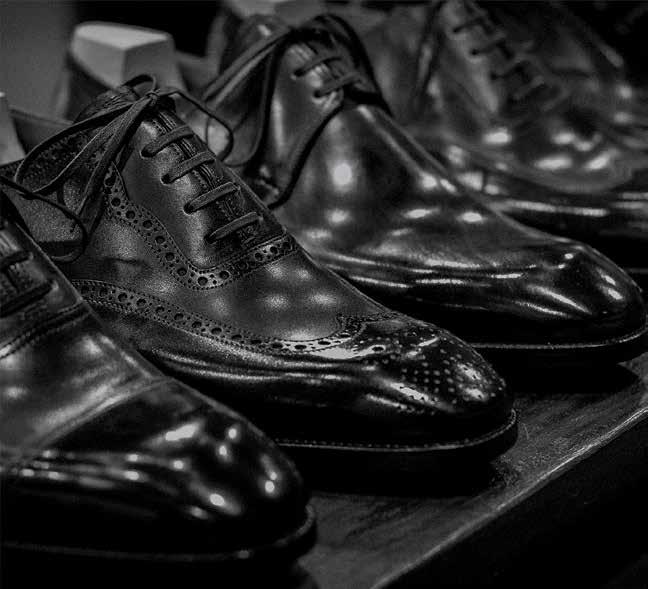
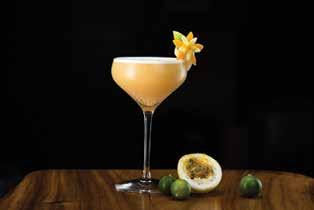




PUBLISHER
Jason Cutinella
EDITOR
Lisa Yamada-Son
CREATIVE DIRECTOR
Ara Feducia
MANAGING EDITOR
Matthew Dekneef
ASSOCIATE EDITOR
Anna Harmon
DESIGNERS
Mitchell Fong
Michelle Ganeku
PHOTOGRAPHY DIRECTOR
John Hook
PHOTO EDITOR
Samantha Hook
EDITORIAL ASSISTANT
Eunica Escalante
COPY EDITOR
Andy Beth Miller
IMAGES
Michael Keany
Lila Lee
Jonas Maon
IJfke Ridgley
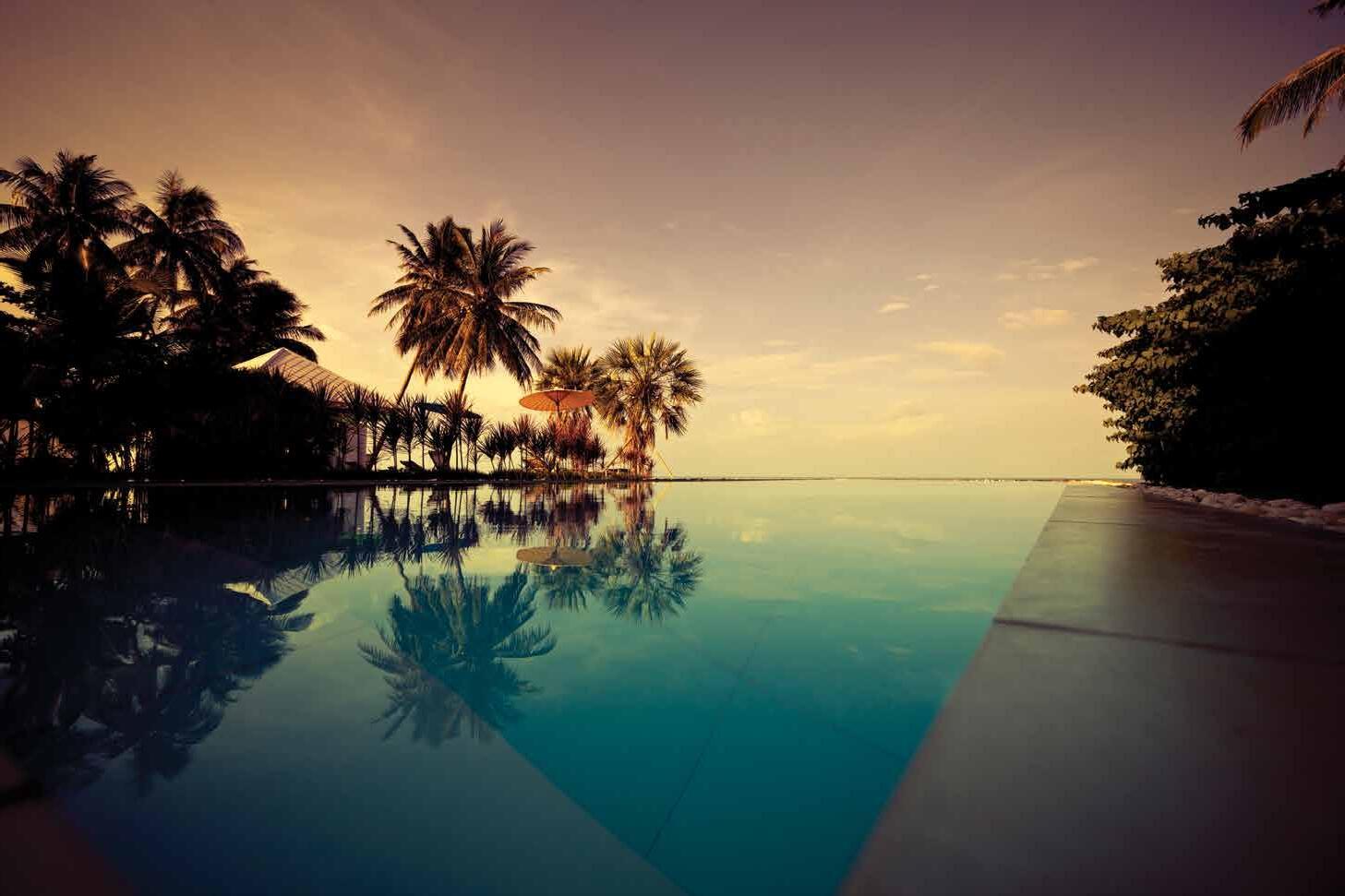


At a boxing gym in Waipiʻo Gentry, Oʻahu, photographer John Hook took this photo of Bree Locquiao, the first female flyweight from Hawaiʻi to win the Women’s National Golden Gloves championship title. Currently, she has her sights set on representing the Islands in the Olympics. Hook dropped in on a training session with Locquiao as part of our photo essay, on page 66, focusing on local athletes, dancers, and entertainers who use motion to inform their everyday beings, both physically and mentally. Watch these subjects in motion in our immersive video series, which can be viewed online and across our @fluxhawaii social media channels. This content is part of an exciting line of lifestyle programming for the NMG Network, a newly launched video platform airing across Hawai‘i and worldwide.

A Kansas native, Timothy A. Schuler writes about design, ecology, and the natural environment.
For the feature “What It Means to Walk” on page 30, Schuler was surprised by how much of the essay was composed while, literally, on a walk. “I’ve long had a habit of taking a walk when I’m feeling stuck or low on energy, and there’s a long literary tradition of doing just that, but here, it became an essential part of the writing,” he says. “Walking while writing about walking created a kind of unfocused attention that allowed my mind to make novel connections, and some days I literally wrote as I walked.”

With her award-winning businesses coverage, Kate Mykleseth has reported extensively on the expansion of renewable energy in the state of Hawaiʻi, formerly as Honolulu Star-Advertiser’s energy reporter. Mykleseth turns her attention to the arts in this issue with her profile on artist Matthew Kaopio on page 26. “His accomplishments reinforced the idea that drastic physical movements aren’t required to reap outstanding impact,” says Mykleseth, who also shot and edited a video profile on the artist. “The gradual and delicate strokes of Kaopio’s brush helped to redefine his purpose in life, and it was inspiring to see him as a physical testimony of a mindset I share, just with a different tool.” When Mykleseth isn’t glued to a computer screen cutting her next audio or video project, you can find her stand-up paddling comfortably close to Oʻahu’s east coast or running the streets of Pālolo.

For this month’s issue, photographer IJfke Ridgley captured the dancers of Ke Kai O Kahiki, the all-male hālau based in Waiʻanae, in our story “A Hula Unearthed” on page 44. “It was moving how much ritual, reverence, and preparation the dancers brought to their weekly practice, even though it wasn’t a public performance,” Ridgley says. “On a technical level, the challenge lay in capturing the movement of each individual dancer while also encompassing the incredible setting at Lanikūhonua. Getting to spend the afternoon with some of the best dancers on the island in the most beautiful costumes was truly a treat.” Ridgley has spent part of the last year living in South America, but always looks forward to coming home to Hawaiʻi.
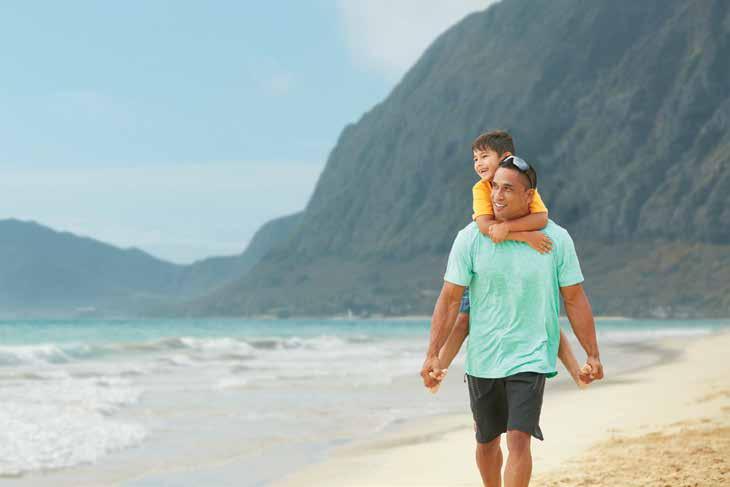

Rollover your 401(k) into an IRA. Ask your new employer if you can rollover to your new workplace’s plan, ask your former employer if you can continue to stay in the current plan, or cash out the account value.† American Insurance and Investments offers:
• Flexibility - a wide array of investment options to choose from
• Single View - manage all of your retirement accounts with American Insurance and Investments
• Tax Advantages - just like your 401(k) or 403(b), an IRA offers important tax benefits†
Meet with a Financial Consultant to discuss all of your options and help you through the process. Call (808) 735-1717 or toll-free (888) 343-5534.
 � A pedestrian jogs through downtown Honolulu. Image by John Hook.
� A pedestrian jogs through downtown Honolulu. Image by John Hook.
“It is the movement as well as the sights going by that seems to make things happen in the mind, and this is what makes walking ambiguous and endlessly fertile: it is both means and end, travel and destination.”—Rebecca
Solnit

Navigator Ka‘iulani Murphy leads Hōkūle‘a home from its three-year world journey.
TEXT BY EUNICA ESCALANTE IMAGES BY JOHN HOOK AND COURTESY OF POLYNESIAN VOYAGING SOCIETYWeeks had passed since Hōkūleʻa had departed from Tahiti, and the weather had not been kind. Swaths of clouds, heavy with the promise of rain, blocked Hōkūpaʻa (the North Star) and Hānaiakamalama (the Southern Cross), star formations that would indicate their coordinates. Kaʻiulani Murphy sat atop the vessel’s koli hōkū, the navigator’s seat, straining her arm toward the night sky. Despite the currents, her hand was steady and sure as she lined it up with the horizon in search of the path home.
Murphy was navigating the Polynesian double-hulled voyaging canoe to Hawai‘i Island for the last leg of its Mālama Honua Worldwide Voyage—no small feat when you only have nature as your guide. Without the use of modern instruments, Murphy relied on traditional wayfinding methods, using her hands and eyes as her compass, and the sky as her map. On cloudy nights like this, when no moon or stars revealed the path, and not even the ocean’s surface was visible, she turned to her instincts, and to what she felt was happening. “It’s just a waiting game,” Murphy says. “Be patient for the clues to reaffirm what you already know. ”
The young navigator was chosen for this leg of the trip for a reason, namely, her confidence and composure that’s able to transcend any storm of situations. The inclusion of female crewmembers, like Murphy, on this trip is significant—in the years past, it was difficult for women to earn spots on voyages. She follows in the footsteps of Shantell De Silva, who was the first female navigator to lead Hōkūleʻa ’s journey from Tahiti to Hawaiʻi. “One of the things that young girls can take from Hōkūleʻa ,” Murphy says, “is that you really can be anything you want to be.”
The navigator first encountered the vessel as a child, on an elementary school field trip. Their paths crossed again while she was a freshman at the University of Hawaiʻi at Mānoa, when a then 19-year-old Murphy attended a lecture by Nainoa Thompson, who, back in the 1970s, was taught the art of traditional navigation by one of its last remaining practitioners, Micronesian master navigator Mau Piailug. Inspired by the stories Thompson told of the people he met and the experiences he had, Murphy set out to earn her own adventures. The next semester, she declared a major in Hawaiian Studies,
� Ka‘iulani Murphy observes the night sky at Hakipu‘u on O‘ahu, where the Hō k ū le‘a launched in 1975. Murphy is only one of two female navigators to be chosen as the lead navigator of a TahitiHawai‘i leg in the canoe’s 42-year history.
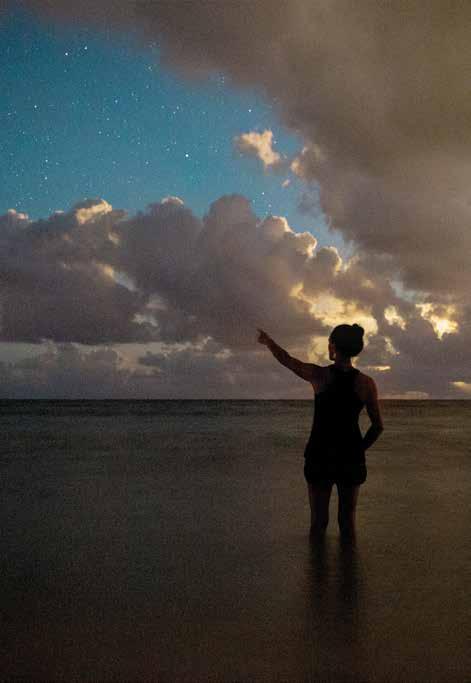

and registered for a course on navigation. Within a year, she was interning at the Polynesian Voyaging Society, assisting Thompson in his preparations for Hōkūleʻa ’s 1999 voyage to Rapa Nui. Hōkūleʻa has long been a symbol for social movements. In the 1970s, the canoe’s successful inaugural voyage to Tahiti helped to restore pride within the Native Hawaiian community. The trip, accomplished without the aid of Western instruments, demonstrated the capabilities of traditional Polynesian navigational techniques. “From the first time that the first missionaries came to Hawai‘i, our culture was devalued, we almost lost our language, and practices like hula were banned,” Murphy says. “The voyaging canoe was one key part of flipping that over, making us aware how intelligent our ancestors really were. That wasn’t in our consciousness until Hōkūleʻa showed us how it could be done.”
After its first trip, the Polynesian Voyaging Society continued Hōkūleʻa ’s travels in order to spread knowledge and pride to communities throughout the Pacific. In 1985, during its two-year Voyage of Rediscovery, the vessel sailed to destinations throughout Polynesia. In the 1990s, No Nā Mamo and Nā ʻOhana Holo Moana took the Hōkūleʻa beyond Polynesia, to islands throughout the Pacific and to ports on the mainland of the United States. The Polynesian Voyaging Society set its sights on the grandest voyage yet in 2014, setting off on the Mālama Honua Worldwide Voyage, a three-year journey circumnavigating the world as a response to today’s threats of climate change. In the last days of this voyage, the crew set their eyes on the horizon. They were on course for Hawaiʻi, as determined by Murphy, having turned toward their final destination at Hānaiakamalama some nights earlier. Within days, the faint
� “It’s just a waiting game,” says Murphy, on wayfinding during unfavorable conditions.
“Be patient for the clues to reaffirm what you already know.”
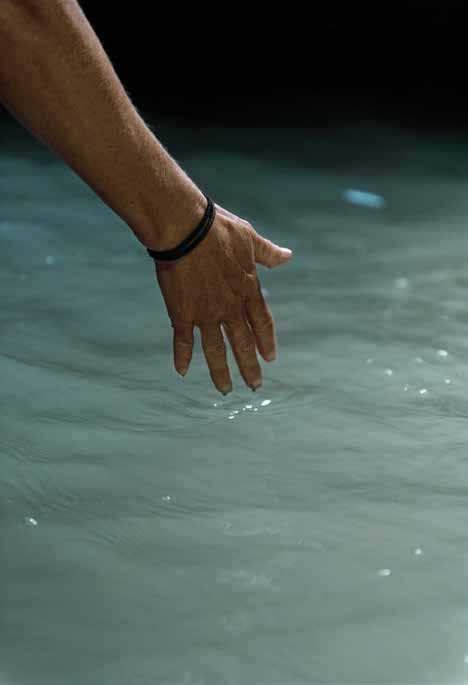
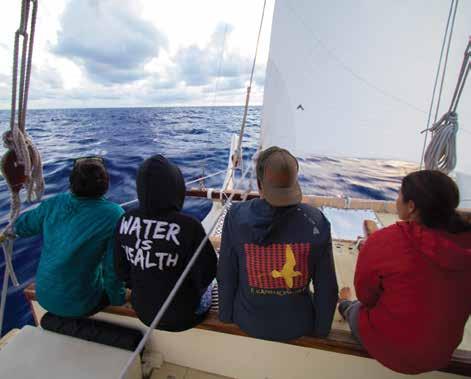
horizon line had grown, and Murphy recognized it as Hawaiʻi Island. “It felt good to finally bring her home,” Murphy says.
Hōkūleʻa arrived on Oʻahu on June 17, 2017, welcomed by a crowd so large that Kālia, Magic Island, was standing-room only. The homecoming signaled the end of the canoe’s epic voyage. But for Murphy, the journey aboard Hōkūleʻa is far from over. “It’s just one continuous cycle, yeah?” she says. “This is the end to one journey, but the start of the next.” Until then, Murphy will be standing on the docks, looking for her next adventure.
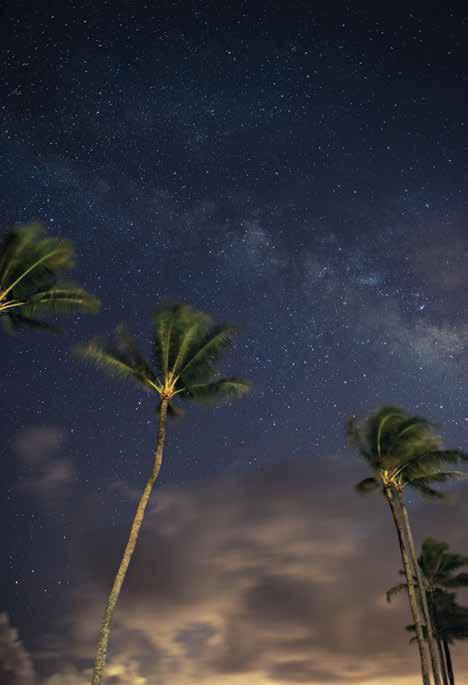
After a diving accident left him paralyzed from the shoulders down, artist Matthew Kaopio finds new ways to express himself.
TEXT BY KATE MYKLESETH IMAGES BY JONAS MAONMatthew Kaopio taps the tip of his paintbrush on the brim of a small saucer filled with water. Ripples of purple spread in the miniature basin and quickly dissolve, leaving a semi-opaque lavender pool resting on the edge of Kaopio’s easel. Different colors of acrylic paints and varying sizes of paintbrushes surround him and the piece holding his focus in the southeast corner of Kahuku Medical Center’s activity room: a nymph with auburn hair overlooking a pond, where a unicorn is embraced by a blonde woman as it bows down to drink from the water. Kaopio brings the brush to the canvas and, with a quick cadence, he shadows a boulder where the nymph lounges. She is perched on the stone as streams of whitewater fall into a dark pool below.
“I’m in the mood to paint something that is out of the ordinary,” Kaopio says. A couple feet outside of Kaopio’s workspace, dozens of his works, some mundane, others fantastical, lean against the wall, all waiting to be sold or gifted to friends: zebras grazing in the midst of a bright orange dust storm, an hourglass-shaped performer holding on to a microphone stand, a sun setting behind Mokoliʻi as waves crash onto the shore. “My dreams are very vivid— I have some incredibly creative dreams,” he adds.
The creation of the nymph’s deep blue pond is surprising when one considers how Kaopio controls his tool: by holding the brush with his mouth. In 1994, Kaopio became paralyzed from the shoulders down after breaking his neck while diving from Waipahe‘e Falls on Kaua‘i. Floating in the water, unable to move, Kaopio thought he had lost the ability to enjoy the activities he loved: swimming, surfing, hiking, even singing and drawing. “From that moment on, I knew life was changed forever,” Kaopio says. “I was probably in a funk for the first three years, just not knowing what the future was going to hold.”
� In defiance of his disability, Matthew Kaopio puts brush to canvas using his mouth to create fantastic works. This method has also doubled as a form of therapy, he says. “I became a lot more accepting of my situation.”


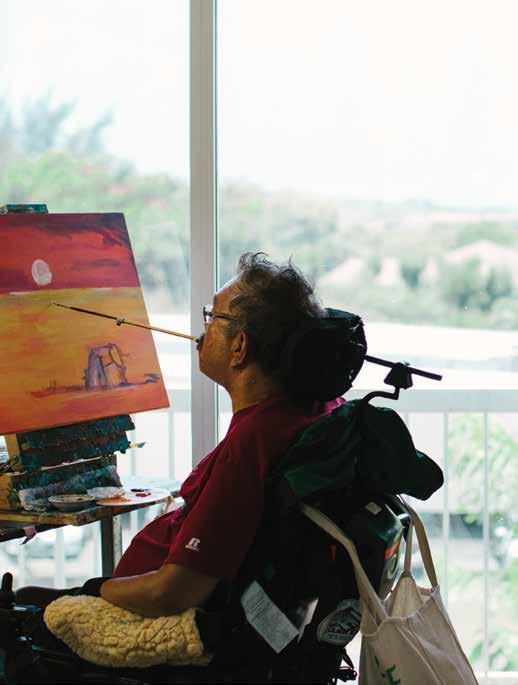

A self-portrait helped pull Kaopio out of his gloom. He signed up for an art therapy program in which painters controlled the brushes with their mouths. After much coaxing by the teacher, Kaopio painted a self-portrait that inspired compliments from the class. He said it came out looking like him, in a “Homer Simpson” kind of way. “I painted it yellow with purple hair,” Kaopio says. “It kind of dawned on me that there are some things I can still do, even though I can’t do it the way I want to. … Seeing myself from that perspective, I became a lot more accepting of my situation.”
To create a painting, Kaopio needs help setting up his tools. The canvas is placed in front of him. The palette and water dish are set below it. He is fitted with a mouth stick. Then, he selects his brush, dips it in one of the dollops of acrylic paint on his palette, and raises it to the canvas. His painting also triggered a different way of thinking that spilled over into his everyday life.
“I decided to try to see how creative I could be to get the results I want,” he says, a realization that emboldened him. He asked strangers to help him get money from his
pocket so he could pay for his groceries. He asked riders around him to push the button for his floor when entering an elevator. “That is when I decided to go back to school and finish my degree,” he says. In 1999, Kaopio completed a bachelor’s degree in Hawaiian studies at the University of Hawai‘i West O‘ahu. Next, he obtained a master’s degree at the University of Hawai‘i at Mānoa’s Center for Pacific Island Studies. After earning his degree in Pacific Island Studies, he wrote his first novel, Written in the Sky, which was published by Mutual Publishing in 2005, followed by Up Among the Stars in 2011. “Writing was like painting using words,” he says.
Back at Kaopio’s corner workstation, the artist cleans his brush in the waters of the saucer. He raises the brush for the final strokes of the painting. The three streams of bright water divide into five as they fall into the pool below; the unicorn is reflected in the pond that fills the mossy landscape. Just as it does the unicorn’s oasis, moving water frames Kaopio’s journey. “If water cannot flow uphill,” he says, “it will carve another path around the mountain.”
� View of Kaopio’s workstation at Kahuku Medical Center. He has completed hundreds of pieces in his more than two decades of painting.
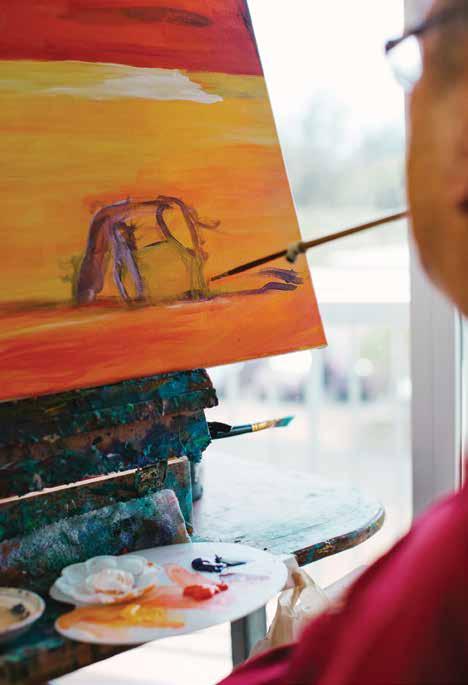
 FLUX FEATURE
FLUX FEATURE
The most mundane of movements, walking is often simply a means of transportation. Yet the act of placing one foot in front of the other has the power to transform the world.
TEXT BY TIMOTHY A. SCHULER IMAGES BY JOHN HOOK
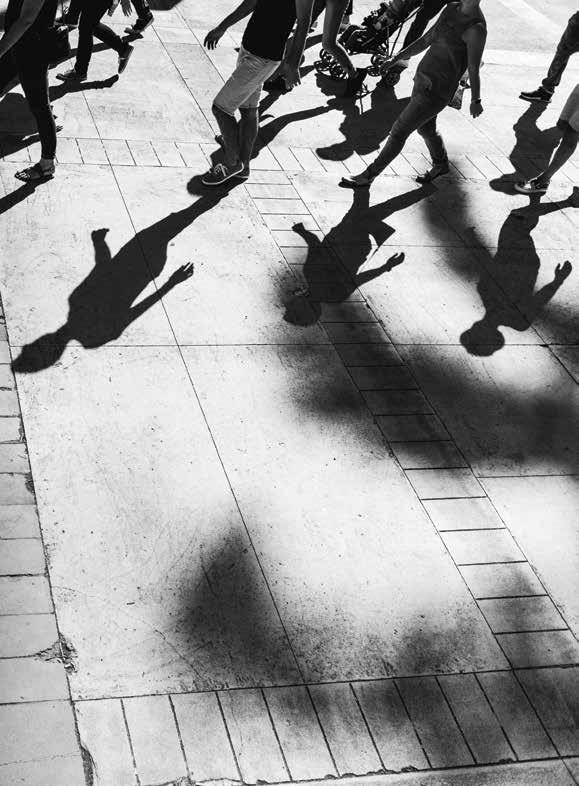
I.The women—and men, and toddlers, and teenagers—were not walking anywhere in particular that day. Although they strode with purpose, soon they were back where they began, spilling off the lawn of the Hawai‘i State Capitol, having trekked less than a mile. Distance, of course, was not a metric anyone cared about. The presidential inauguration had taken place just 24 hours earlier, and the Women’s March in Honolulu was one of 600 similar actions around the world, with more than two million people protesting an American president they saw as being a direct threat to themselves and their values.
In Honolulu, an impenetrable layer of clouds cocooned the city as an undulating column of pink shirts and hand-painted cardboard signs stretched from the Frank Fasi Building to ‘Iolani Palace. The march had swelled beyond the sidewalk and onto the rain-slicked streets, and even during the intermittent downpours, the mood was somewhere between buoyant and defiant. We were 5,000 miles from Washington, D.C., and yet in our collective motion, we became part of a global protest.
Around the world, and across centuries, acts of resistance often have taken this simplest of forms: walking. In Wanderlust: A History of Walking , Rebecca Solnit writes of participating in a protest at the Nevada Test Site, where, from the 1950s to the 1990s, the U.S. military detonated nuclear bombs. Hundreds of protesters camped on the fraying landscape. She writes, “The form our demonstrations took was walking: what was, on the public-land side of the fence, a ceremonious procession became, on the off-limits side, an act of trespass resulting in arrest.”
She continues, “It was a revelation to me, the way this act of walking through a desert and across a cattle guard into the forbidden zone could articulate political meaning.”
Walking has long been a form of protest. Gandhi famously walked 240 miles from his ashram to the coastal village of Dandi in 1930, joined along the way by thousands of Indians. The walk became known as the Salt March, a three-week-long act of civil disobedience that helped spark the Indian independence movement. In Hawai‘i, plantation workers regularly organized walkouts throughout the first half of the 20th century, like when, in May 1937, 2,500 Filipino plantation workers walked from Wailuku to Kahului to call for equal pay. More recently, in Australia, a 27-year-old aboriginal activist walked some 3,000 miles from Perth to Canberra, protesting the government’s treatment of aboriginal communities.
Even the languages of protest and walking are intertwined. The word “march” comes from the French marcher , which means “to walk.” Of course, soldiers marched before pacifists did, and so the language of nonviolent protest also borrows from war: The African-American men and women who marched in Selma and Birmingham were called foot soldiers.
One of the strangest aspects of the Women’s March was simply the sight of so many walkers in Honolulu. Outside the thrumming hive of Waikīkī, few people traverse the city on foot (besides the inevitable journey to and from their vehicles). Honolulu is not a walkable city. It lacks the density of New York City and the pedestrian scale of Paris. Its biggest growth spurts occurred in the 20th century, after the advent of the automobile, which arrived in Hawai‘i in 1899 and forever altered the future form of its capital. With the exception of historic districts like Chinatown, which remains one of Honolulu’s most walkable—and, not coincidentally, most attractive— neighborhoods, the city is dominated by streets designed for cars.
Recently, however, Honolulu-based artists, activists, and public health advocates have discovered walking as a medium for *From U.S. Census Bureau. car: 81%
4.5%

telling stories, combating gentrification, or simply promoting pedestrianism. No matter why we do it, walking tends to offer us something beyond its express purpose, an extra layer of experience and meaning that is all too often ignored. “It is the movement as well as the sights going by that seems to make things happen in the mind,” Solnit writes, “and this is what makes walking ambiguous and endlessly fertile: it is both means and end, travel and destination.”
II.As children, we are not taught to walk. It is innate, unlike language. Leave a healthy human child to its own devices, and it will eventually pull itself up on two legs. We walk because we are designed to walk.
And yet we spend little energy thinking about it. “Isn’t it really quite extraordinary,” Honoré de Balzac wrote in his 1833 essay, Théorie de la Démarche, “to see that, since man took his first step, no one has asked himself why he walks, how he walks, if he has ever walked, if he could walk better, what he achieves in walking?” In the nearly 200 years since Balzac’s time, scientists have studied everything from the evolutionary benefits of bipedalism to its effect on cognition—and yet in many ways, walking remains, in
Solnit’s words, the “most obvious and the most obscure thing in the world.”
We used to walk more than we do today, and not only because there were fewer ways to get around. Throughout history, people have walked for penance, for sport, to achieve enlightenment, to test the limits of the human body. Artists from Richard Long to Francis Alÿs have made art out of the act. In 2004, Alÿs walked 15 miles of Jerusalem’s so-called Green Line, the border established after World War II, all the while holding a can of leaking green paint. In Phoenix, there exists an entire institution dedicated to artful ambulation: the Museum of Walking, created by the artist Angela Ellsworth in 2014.
Like most people, I started walking when I was about one and a half years old. I didn’t give it another thought until 2008, when I was working my first postcollege job, at the Honolulu Weekly. I had been assigned a piece about the state’s master plan for Diamond Head, and after a tour and interview with an official park spokesperson, I decided to explore the areas around the outside of the crater rim. I had wandered for maybe an hour, not looking for anything in particular, when, on the ocean side, I saw a trail cutting into the brush. I followed it up the slope and around several switchbacks. Without warning, I walked
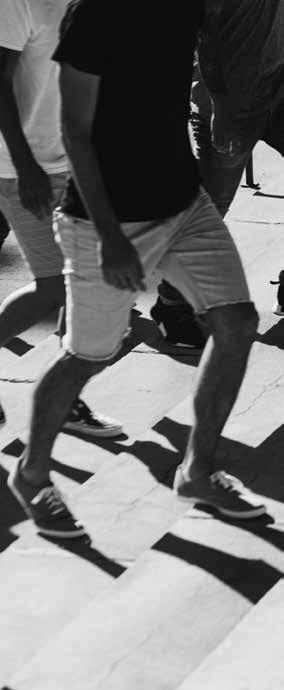

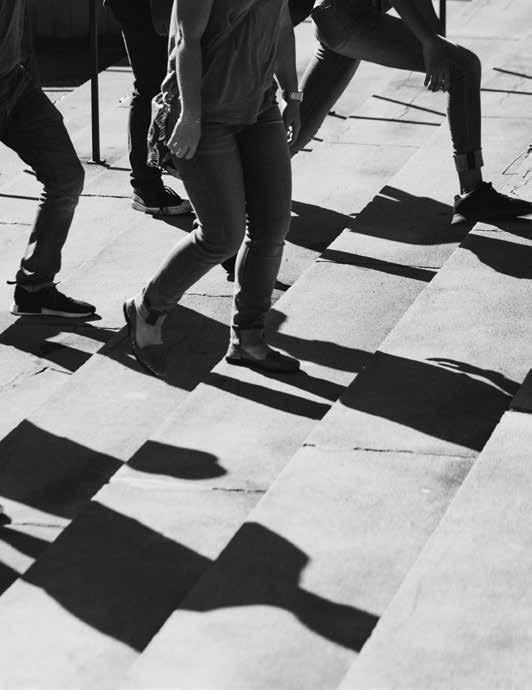
into a makeshift village. A dozen or so tents were scattered among haole koa trees, dirt paths spidering off to each like a planned subdivision. Near one, a stuffed Tigger doll lay in the red-brown dirt.
After a few minutes at the camp, I made my way back to the road, to the realm most of us inhabit and never leave. I learned that day that the only way to really see the world is to walk. In our cars we whoosh by, blind to much of the world, particularly to its most defenseless populations and the vast inequities that create them. But to walk is to make ourselves vulnerable, a precondition for transformation.
A few months later, I moved to Chicago. I kept walking, and invited others to join me. We would meet first thing in the morning and embark on what I started calling “urban hikes,” walking as many as 15 miles through rock quarries turned public parks and partially abandoned industrial districts. I became familiar with the term “psychogeography”—the idea that the built environment affects our thoughts and behavior—as well as the eccentric French group known as the Situationist International, which coined it.
Led by a Marxist theorist named Guy Debord, the Situationists appear in nearly every written history of walking. Formed in Paris in the 1950s, they were staunch critics of capitalism and had the lofty idea that they could achieve higher consciousness by walking aimlessly through the city. They weren’t successful in overturning Western capitalism, but at least one product of their thinking has persisted: the dérive, or “drift.” A dérive, to Debord, was an amorphous form of walking in which a group of people abandons all “usual motives for movement and action, and lets themselves be drawn by the attractions of the terrain and the encounters they find there.”
It’s a pretentious notion, and yet, I do walk this way sometimes, eyes open, allowing myself to be drawn by the character of a street, or by the promise of a path whose end I cannot see. Today, drifts are organized around the world, and there are even apps to facilitate them. They’ve been especially popular in New York City, where from 2003 to 2012, there existed a semi-annual psychogeography festival called Conflux, a weekend of themed walks and walk-themed talks. One year, attendees walked through the city guided by a map not of New York, but of Copenhagen, in order to scramble traditional notions of navigation and discover new avenues through the city.
Among the organizers of the 2010 Conflux festival was a young woman named Adele Balderston. Balderston, a geographer and artist, grew up on the windward side of O‘ahu, and moved to New York City for school in 2004. A decade later, she moved back to Hawai‘i and created 88 Block Walks, a series of walking tours that feature oral histories and photographs of Kaka‘ako—ground zero for new development in Honolulu and the controversies that accompany it. The walks, which grew out of an interest in active forms of combating gentrification, are an attempt
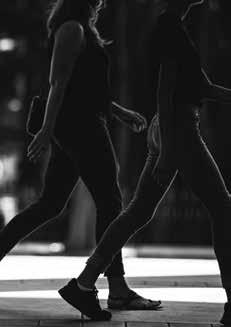
�
“I don’t think you can just poke at people and say, ‘I’m encouraging you to walk more,’” says Matthew Gonser, co-founder of the community advocacy group Better Block Hawaii. “We have to work on the physical environment. We have to make it appealing.”
at reclamation. “I’m trying to take back control of the narrative of this place from developers,” Balderston tells me one evening before her fifth and final Kaka‘ako walk, titled “The Living Archive.”
Balderston, who has delicately tattooed arms and a round face dwarfed by large, vintage-looking glasses, started walking regularly when she moved to New York. Mainly, it was a necessity—she didn’t have a car—but it was also a way to get her bearings, to begin piecing together the neighborhoods in which she lived. Searching for an analogy, she asks if I ever played the video game The Legend of Zelda .
“This is really nerdy, but you know how in the beginning you just have those four little squares and everything else is obscured because you haven’t been there yet? It was kind of like that,” she says. “I had to walk each square for that to be part of my mental map of the place. That’s how it started.”
Balderston’s Kaka‘ako tours take place at night. At points along the walk, she projects historic photos of
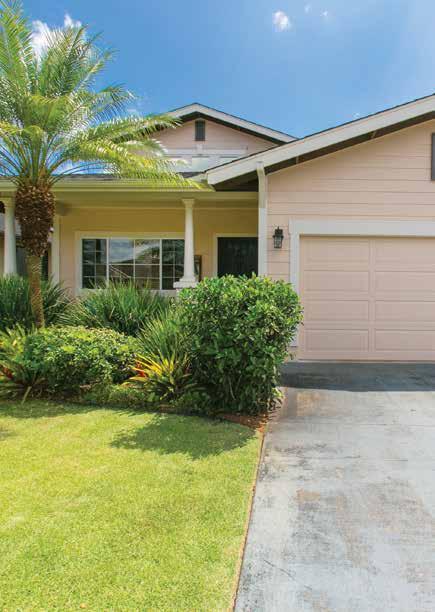


the neighborhood onto walls of existing warehouses. The images are accompanied by monologues performed by trained actors, adapted from essays housed in UH’s Romanzo Adams Social Research Laboratory Collection. The first stop of “The Living Archive” is on Ilaniwai Street, where a few small storefronts face the back of a large warehouse. Here, Balderston takes people back to the 1920s, when the neighborhood was on an upswing, with new housing for families. In the decades that followed, the area was rezoned, displacing many of the residents. In the high-rise development happening today, Balderston sees familiar cycles of disinvestment and dispossession. “They’re calling it a ‘new place,’ but it’s like, no, this is a hundred-year-old neighborhood,” she says. When modern developers mention the community’s history, she says it is often romanticized, limited to the life of Victoria Ward or the saltponds of a precontact Hawai‘i. There’s little mention of the everyday people who lived and worked in 20th century Kaka‘ako, or of the informal settlement known as Squattersville, a community of close to 700 Native Hawaiian and hapa families that existed along the waterfront.
Later, Balderston and I retire to a table at Bevy. It’s early, but the bar is filled with the noise of overlapping conversations. Balderston has lived in some of the world’s most walkable cities—New York, Paris, Seattle—and when she was in those places, she says, walking “was like breathing.” Honolulu is different, she says. The city, with its mess of streets and absent sidewalks, can be punishing for pedestrians, even deadly. In both 2014 and 2016, according to reports by Smart Growth America, Hawai‘i had the highest fatality rate for pedestrians aged 65 or older in the country. For one of her walks, which partly followed a busy street, Balderston made attendees wear reflective vests and bike lights, so that no one would be maimed.
Honolulu’s general lack of walkability creates a negative feedback loop that exacerbates the problem. Walkers tend to feel safer around other walkers, which means that the less people walk, the more
dangerous it feels. “Strange places are always more frightening than known ones,” Solnit writes, “so the less one wanders the city the more alarming it seems, while the fewer the wanderers the more lonely and dangerous it really becomes.”
Not long ago, I attended a very different kind of walk. The route was undefined, as was the distance, which was fine because, like the Women’s March, this walk wasn’t about reaching some predetermined destination. It was about simply encouraging people to walk—and understanding why they don’t.
The walk took place in Pearl City and was organized by Colby Takeda, a young, clean-cut O‘ahu native who works for The Plaza Assisted Living, a group of senior housing facilities on O‘ahu. It was one-part art project, one-part public health initiative. Students from the Center for Tomorrow’s Leaders, a leadership program for high school juniors and seniors, accompanied Plaza residents on short walks through their communities, documenting the experience with digital cameras. After, the residents talked about what they photographed, and discussed whether or not they considered the neighborhood “walkable.” Takeda hoped the walks would put the youth in the kūpuna’s shoes, and also generate ideas for how to make O‘ahu’s streets safer for pedestrians.
The project was also part of Jane’s Walk, a global movement of “citizen-led walking tours” inspired by Jane Jacobs, the bespectacled urban thinker who wrote The Death and Life of Great American Cities . Jacobs believed that “cities have the capability of providing something for everybody, only because, and only when, they are created by everybody.” Jane’s Walk got its start in Toronto in 2007. Since then, it has expanded to more than 200 cities. Thousands of Jane’s Walks take place every year, exploring everything from the rich cinematic history of Santos, Brazil, to the unique roji (alleys) of Tokyo.
WHAT MAKES A NEIGHBORHOOD “ WALKABLE? ”
- a main center
- enough people
- affordable housing
- buildings close to the street
- schools and work nearby
- streets designed for bicyclists, walks, and transit
WHAT MAKES WALKS SAFE FOR PEDESTRIANS?
- streetlights
- clearly marked sidewalks
- well-timed crosswalk signals
- protected intersections

Honolulu’s first Jane’s Walk took place in May 2014. It was organized by Matthew Gonser, a co-founder of the community advocacy group Better Block Hawaii, and who is now with the Honolulu Office of Climate Change, Sustainability, and Resiliency. Gonser has been advocating for a safer, more walkable Honolulu since he moved to the city in 2012. Two years ago, he organized a Jane’s Walk to raise awareness about pedestrian safety. Participants—a mix of designers, planners, interested residents, and city employees, including the deputy director of Honolulu’s Department of Transportation Services— walked from Alapaʻi Street to University Avenue, intentionally crossing King Street at each un-signalized, mid-block crosswalk (which is striped, but does not have a stoplight). The aim was to demonstrate how treacherous these types of crossings are, and to encourage the city to take action. Honolulu has a mandate to make the city safer for pedestrians. Amended in 2006, the city’s charter states: “It shall be one of the priorities of the department of transportation services to make Honolulu a pedestrian- and bicycle-friendly city.” And yet, according to Hawai‘i Department of Transportation reports, pedestrian deaths have continued to rise in Hawai‘i, by as much as eight percent between 2014 and 2016. This year, the city banned looking at a cell phone while crossing the street, a law most experts agree unduly punishes pedestrians. “You, as a person walking, are such an easier target for enforcement,” Gonser says.
The people most affected by Honolulu’s poor walkability are the homeless and the elderly. According to one study released by the Centers for Disease Control and Prevention, which looked at Clark County, Nevada, homeless people were killed in pedestrian deaths at more than 20 times the rate of residents and visitors. In Hawai‘i, seniors who walk are at nearly three times the risk of being killed in a traffic accident when compared with the rest of the country, according to national statistics.
At Takeda’s walk in Pearl City, the deficiency of Hawai‘i’s built environment was apparent. Watching residents like Carl, a small, mostly silent gentleman who shuffled down the street using a walker, it was clear how unwelcoming the built environment can be for the elderly. For instance, the crosswalk nearest the Plaza was almost 700 feet away, at the bottom of a hill. If a person wanted to walk to the shopping center across the street, he or she would have to walk down to the crosswalk, cross, and walk back uphill. At an average pace, it would take about 10 minutes, an annoyingly long time to get somewhere right across the street, but doable. If you’re Carl, it’s out of the question. It would take him roughly half an hour just to reach the crosswalk, and longer to complete the opposite leg. That’s an hour’s walk to get from his home to the Sam’s Club across the street.
Later, when the group shared their photos, it was one of Carl’s that struck me as the most profound. Taken from about chest high, the slightly blurry photo was almost certainly an accident. In it, you see his walker, his laminated nametag affixed to the plastic handlebar, and his slippered feet on the sidewalk. What stood out to me, however, were the walker’s wheels, one of which was in the grass. It turns out that the sidewalk in front of the Plaza isn’t even wide enough for two people to walk abreast, certainly not when one person uses a walker or a wheelchair.
Most experts agree that the best way to reduce pedestrian deaths is to rethink our streets. Wide streets with infrequent intersections naturally encourage drivers to go fast, regardless of the posted speed limit. The faster the traffic along a particular roadway, the less pleasant and safe it is for pedestrians. A human body has a 93 percent chance of surviving an encounter with a motor vehicle traveling 20 miles per hour. But if that car is going 45 miles per hour—not uncommon on a wide street like Ala Moana Boulevard—the survival rate drops to just 40 percent, or 17 percent for the elderly.
There’s something rewarding about exploring the world on foot and realizing so much of it is, in fact, open to you. You can linger at streams and loiter in public plazas. You can walk to the edge of the city, and simply keep going.
� Walking has been shown to reduce stress, improve sleep, and generate economic activity. The challenge for Honolulu is to design communities more attractive for and encouraging of pedestrians.
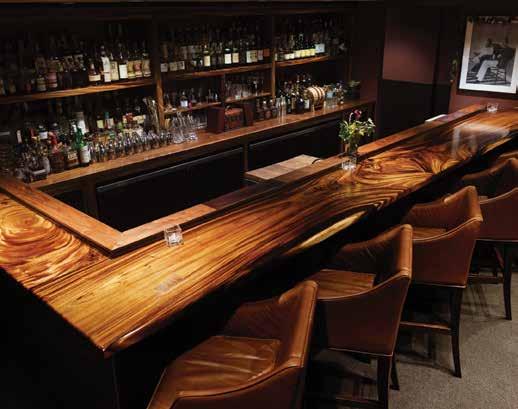
To slow traffic speeds, cities around the world are implementing “road diets,” adding traffic-calming measures like speed humps, narrower lanes, traffic circles, raised crosswalks, and trees planted along the street. Coincidentally, elements like these also often improve the pedestrian experience, and not only by increasing the chances of surviving a walk to the grocery store.
Recently, walking advocates got another arrow in their quiver. In December 2016, the New York State Supreme Court ruled that cities, and not just drivers, can be held liable for vehicular incidents. The decision, in which New York City was found 40 percent liable for an accident involving a speedy driver and a bicyclist, and was ordered to pay $8 million to the defendant, is one of the first to recognize that a city’s physical form directly affects the behavior of its drivers.
A city’s form also affects whether and where we walk. Pedestrians naturally gravitate to the shady sides of streets, as well as to areas with other pedestrians. If Honolulu wants to encourage walking— and it should, given that walking has been shown to reduce stress, improve sleep, lower a person’s risk for Alzheimer’s, and generate economic activity—it will have to rethink its streets and public spaces. “I don’t think you can just poke at people and say, ‘I’m encouraging you to walk more,’” Gonser says. “We have to work on the physical environment. We have to make it appealing.”
Solnit says you never really know a place until it surprises you. One of the most surprising places I’ve discovered while walking in Honolulu is a hidden stairway off Magellan Avenue above the H-1 freeway. It’s at the edge of a small, bowlshaped park almost completely enclosed by tall rock walls, with a boarded-up field house and a solitary, plastic playground. Like the park, the stairway feels leftover. No path leads to it. It simply starts at the
edge of the grass, its stone steps curling around a massive banyan tree whose roots form spaces littered with trash and broken bottles. Near the top, the stairway narrows to a dark channel as it cuts into the cliff. Then it opens, suddenly, onto a large, graffitied basketball court.
I’ve walked the stairway multiple times, and each time, going from the dark, enclosed cavern of the tree canopy to the exposed expanse of asphalt, feels like stepping through a portal. Such distinct shifts in the city’s urban fabric often happen between neighborhoods, or between streets. These two spaces, on the other hand, create a sort of friction in their adjacency.
Henry David Thoreau, America’s most famous literary walker, wrote, “Two or three hours’ walking will carry me to as strange a country as I expect ever to see.” I suffer from the same mild wanderlust. While I feel only the smallest compulsion to book flights to foreign countries, I feel a strong pull to walk the places I call home, and have a toddler’s tendency to wander off. It has, I think, something to do with freedom. In modern society, even walking down a street that isn’t yours can feel like trespassing. But there’s something rewarding about exploring the world on foot and realizing so much of it is, in fact, open to you. You can linger at streams and loiter in public plazas. You can walk to the edge of the city, and simply keep going. Without engines, gears, axles, we discover that more is possible, not less—there is a sense of empowerment in recognizing that we are freer than our departments of transportation would have us believe. Sidewalks become dirt paths, which become wilderness, and still we can walk, constrained by nothing but our own physical capacity.
This freedom is what is being enacted when we march. To walk in a place is to reclaim it, even for a moment. These small reclamations have set in motion entire reorderings of nations. At some point, a long time ago, human beings figured out that by simply walking, they could change the world. One foot in front of the other, until nothing is as it was.
Honolulu Mililani Mauka 15
POPULATION
337, 256 Mililani Mauka
21 ,039
Downtown Honolulu
*From walkscore.com.
� A one-mile walking radius in downtown Honolulu, Hawai‘i’s most walkable neighborhood, and Mililani Mauka, O‘ahu’s least, where almost all errands require a car.
 FLUX FEATURE
FLUX FEATURE
With one of hula’s most athletic and ancient dances, the men of Ke Kai O Kahiki excavate the fundamentals of the form’s multi-layered tradition.
TEXT BY MATTHEW DEKNEEF IMAGES BY IJFKE RIDGLEY
� Kumu hula La‘akea Perry and dancer Sunny Leutu.

Ahand slices through the air. In concert with the foot, leg extended and parallel to the arm, it thrusts forward in a precise and steady motion. Matching the hollow thud of a wooden gourd, hands and feet travel to the absolute reaches of their limbs, return to center across the mouth and groin, then repeat, one, two, three. Suddenly, the hula dancers, all men and all in recline, rise from the ground in a single sweeping motion, bodies hovering above the terra firma, balancing themselves confidently on a single arm and foot. Uprooted, they sway, ebbing and flowing, accelerating to a crescendo of eruptive backbends, their necks and shoulders flexing just inches from the ground as their sculpted bodies quake like mountains of their own making.
This is hula ʻōhelo, a brisk and energetic dance that is rarely seen today. At Lanikūhonua, a parcel of land on Oʻahu’s west side where Ke Kai O Kahiki trains, the male hālau performs its impressive and peculiar movements to the percussive chant “Tū ʻOe.” The kāne, men who range in age from their 20s to 30s, aim to perfect the pulsing rhythm of this ʻōhelo, the distinctive “seesaw” of the dance (also the meaning of the word, ʻōhelo), before progressing into even more complex floor work. One doesn’t have to be fluent in hula’s nuances to gather that it is an especially difficult and disciplined dance. To the modern eye struggling to make sense of its motions—the pointed toe angled at a concise degree; the palm, turned downward and flexed; the seismic swing, all which carry meaningful weight— the dance recalls a mix of CrossFit and ballet. Its gestures clearly strain the body. When Ke Kai O Kahiki first performed “Tū ʻOe,” for the kahiko night of the Merrie Monarch Festival in 2009, it blew open casual notions about what hula is and what it looks like by employing explicitly athletic and relentlessly masculine motions. With it, the hālau swept the competition, winning the year’s coveted overall title and becoming an instant Merrie Monarch classic. It is watched and re-watched by hula enthusiasts the world
over to this day—an online search for it is easy to find (it’s the video with more than 1.5 million views on YouTube). What is more notable, though, is that it reveals the excavation of dance movements many spectators had not even known existed in the canon of hula. “The motions were so unusual, learning it for the first time was like wiping the slate clean,” says Laʻakea Perry, who was the lead dancer at front and center during that performance eight years ago. Even with two decades of hula experience to his name, all spent under the tutelage of Ke Kai O Kahiki and the late O’Brian Eselu, its founding kumu hula, Perry initially found the ʻōhelo strange and uncomfortable. The unfamiliar steps, strung into exacting sequences and requiring constant adjustments to refine, test a dancer’s agility and strength. “We trained one year for that ʻōhelo,” Perry remembers. “In all my hula learning, the dance and its movements were something I’d never done before, and now I’ll never forget how to do.” Backbends combined with continuous ʻami, or hip rotations, for eight counts, for instance, elicit fevered applause from hula fans, in awe of the hālau’s ability to make such technical floor work appear so easy. In hula ʻōhelo, one misstep and the dancer is exposed, with no time to cover any flaws.
Prior to its Merrie Monarch debut, the last documented public performance of hula ʻōhelo may have been more than 150 years prior. In a brief chapter in the early 20th century tome Unwritten Literature of Hawaii, historian Nathaniel B. Emerson transcribes a vague account of its display to the year 1856 in ʻEwa (coincidentally the same general area of Oʻahu where Ke Kai O Kahiki is based). It’s accompanied by a mele maʻi, or a procreation chant, which celebrates the proliferation of future generations of aliʻi. But, even without this awareness, the viewer is coaxed toward the dance’s fertility themes by the gestures themselves: the men, minimally clothed, are in recline; the leaned body pushes, prods, thrusts; the finale peaks with a tantric climax. “The whole action, though fantastical, was conducted with modesty,” Emerson concludes.

To the modern eye struggling to make sense of ancient roots, the dance recalls a mix of CrossFit and ballet.
� Dancer Julian A. Maeva demonstrates the starting movement in hula ‘ō helo, a peculiar style atypical to other hula noho, or seated dances. From here, the progression goes from simple to complex.




Reawakened is perhaps a better word than rediscovered when tracing the trajectory of hula ʻōhelo from past to present. Like many Hawaiian customs suppressed under missionary authority, hula continued to persist, albeit more secretively, through unwavering practitioners. Its spiritual and ritualistic nature, incongruent to the conservatism of the century’s new societal influence, left hula at constant risk of erasure; because of its strong sexual connotations, the genus of hula ʻōhelo was potentially even more vulnerable. Pair this with the form’s sheer archaism, even during Emerson’s time (“It is safe to say that very few kumuhulas have seen and many have not even heard of the hula ʻōhelo,” he wrote), and its movements grew increasingly austere with each passing generation. Even in the hula ‘ōhelo that has survived, the manner in how the hands follow the feet—in “seesaw” with with minimal interpretation or allusion to the chanted text—highlight a hallmark of its antiquity, according to Taupōuri Tangarō, a kumu hula and the director of Hawaiian culture and protocols engagement for the University of Hawaiʻi at Hilo and Hawaiʻi Community College. Tangarō first encountered two hula ‘ōhelo dances in the 1980s, one for the ʻipu (gourd), the other for pahu (drum), on the heels of the Hawaiian Renaissance as a 19-year-old student of Hālau O Kekuhi, the regarded Hawaiʻi Island hula company founded
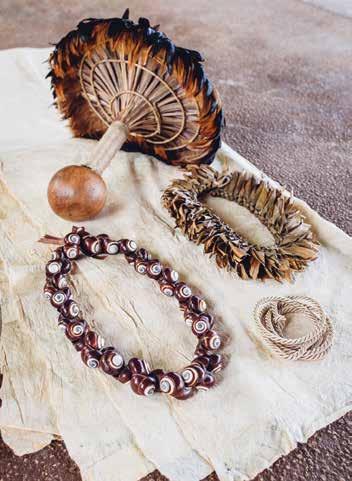
by Edith Kanakaʻole. The dances, he was informed, are related to fishermen returning home from cold nights at sea, who would warm themselves by dancing around a fire. Traditionally, this is how hula ‘ōhelo was danced— imagine now a circle and a corona of limbs stoking a flame—a formation that still has yet to be revitalized. “By design,
hula ʻōhelo is not soft and feminine, but sharp and masculine,” Tangarō says, suggesting that ‘ōhelo’s orientation toward the fire, a central and archetypal symbol for the sacred feminine, had a multi-tiered significance. “By doing it in the presence of the fire is to offer up again an intercourse of the male energy of the dance and the female energy of the fire. This is
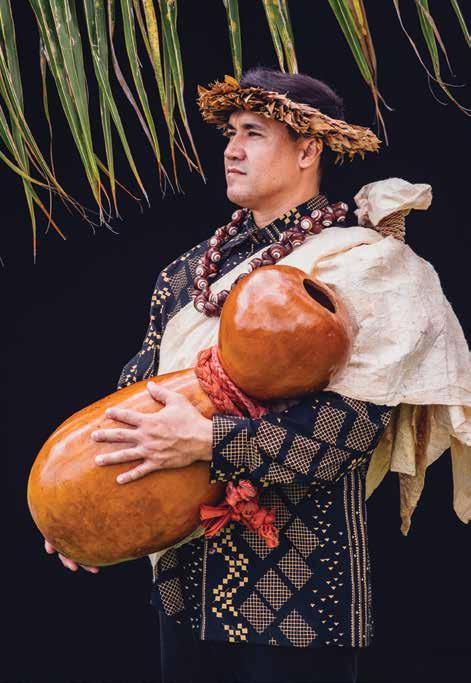



potent, the balance of male and female, in many oceanic indigenous religions.”
When Eselu first heard of hula ‘ōhelo it was through word of mouth in 1985. He was 30 years old, still an emerging kumu hula himself, and became determined to learn it. Eselu sought his source, Nālani Kanakaʻole, the daughter of Edith, to gain proper information on the dance; Nālani still retained knowledge of hula ʻōhelo and its rarefied movements, in the tradition of Samuel Pua Haʻaheo, a hula master from Kahana Valley. It was Nālani’s husband, Sig Zane, who provided crucial details on certain hand motions identifying the lesserknown male version. But it wasn’t until he founded Ke Kai O Kahiki, his all-male hālau over a decade later, that timing would strike: Haʻaheo, it turns out, is also the great grand-uncle of Perry, Eselu’s star hula student. Together, the two had the privilege to continue this familial dance tradition. “That dance that year at Merrie Monarch was very special and important for me, and for O’Brian,” Perry says, “as it was a way for me to pay tribute and represent my ‘ohana.”
Under Eselu, the two commenced in reanimating the ʻōhelo for the world’s largest and most visible hula stage. Eselu’s guiding vision for his all-male troupe was to push the boundaries and biases about men
who practice hula—a sentiment that culminates in the hālau’s hula ʻōhelo, which emphasizes fluid hip movements combined with ‘ai haʻa, an emphatic class of hula that involves dancing very low to the floor, often in a stout, full-squat position. “Our style is often described as bombastic, as very strong, almost mimicking or replicating martial arts and Hawaiian lua, very warriorlike,” says Perry, who is now the kumu hula of Ke Kai O Kahiki, and who continues this dance tradition passed down to him by Eselu. “But if you look deeper into the style, it’s not just about the masculine look of it. There’s another level beneath there, where you can see the connection between its manly side and its softer side.”
To prepare for the dance, training is grueling. Hours of attention are dedicated to hula basics. The men also turn the landscape of Lanikūhonua into their conditioning gym: They climb coconut trees as quickly as they can; do duck walks across the length of its 10-acre fields; run drills on the sandy beach that fronts the property and along the ocean floor, weighing themselves underwater by carrying heavy boulders in their arms. “We have to reshape our bodies to do this dance,” says Sunny Leutu, who, after Perry, is the longest dancing hula member of Ke



Kai O Kahiki. Those who are unready often fail to complete it. “Your body is burning to that point, and every time you start feeling that pain, you give up, and ruin the dance,” Leutu says. “But when your muscles gave out, that’s when you’d find out how far your mind could take you. If you let your mind push your body, it’s really about mind over matter, telling yourself, ʻFinish this.’ You get stronger and stronger every time.”
Hula’s code prides, above all else, a story. Its rousing athleticism is neutered when disconnected from the movements its dancers strive to enliven, because hula, in its physical traffic of symbols and metaphoric imagery, inundates the viewer with richly detailed accounts of gods, of nature, of its people. Its dance gives literal shape to the oral tradition on which it is based—no step, bend, nod, or sway is arbitrary or ornamental. To lose a chant, a dance, or even a single movement, is to lose more than mere choreography; it is to sever a connection of the Hawaiian people to a sacred realm and identity so elemental to the soul of the islands. Under this context, consciously or unconsciously, hula ʻōhelo electrifies what makes hula so affecting at its core in this present day: to witness the power and poetry of reclamation in motion. On the lawn of Lanikūhonua, the kāne near the end of their hula ʻōhelo. Their levitated bodies draw back to where

they began, settling back down into the soil, one again with the earth. Their kumu chants the final phrases of the dance, and the energy between he and his students swells with an unseen cosmos of an ancient tradition passed down for centuries. The kāne, whose hands have now turned into fists held
at their waists, station themselves and gaze ahead. Still as the sea behind them, they wait on the kumu’s command to break this pose. For their hands and their arms, to once again, slice through the air. To wield their bodies and reach back into history. They will move to show that all is not lost.
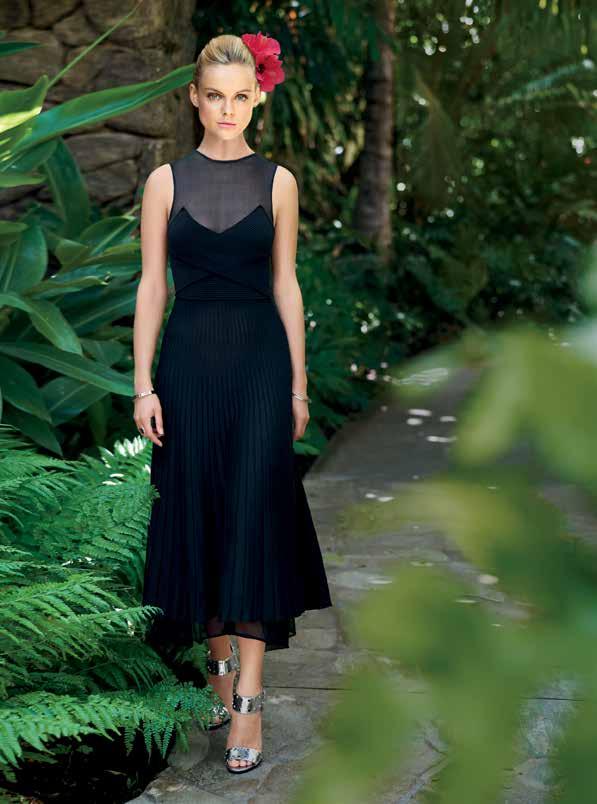
One writer discovers her own strength while paddling through currents of the sea.
BY MARTHA CHENG
BY JOHN HOOK
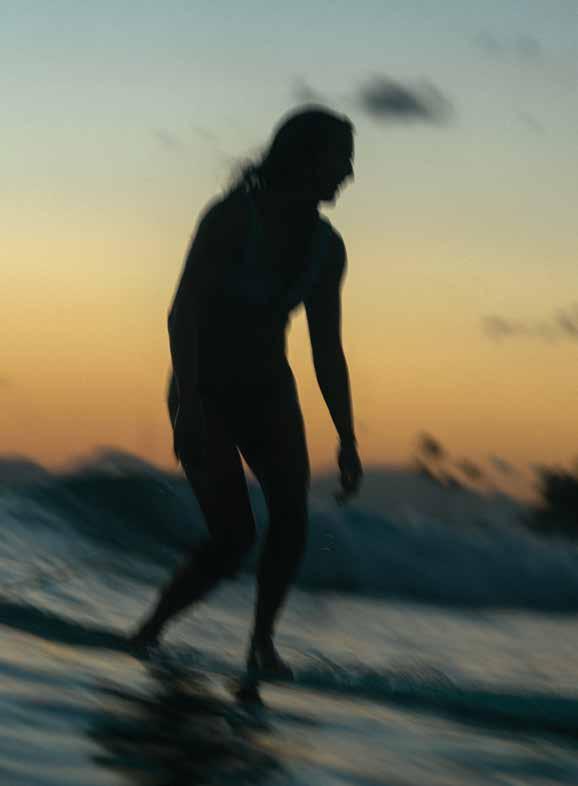
There are days when I can move no farther than the 400 square feet of my Mānoa apartment. And then there are days when I set out to cross the 32 miles between Moloka‘i and O‘ahu on a prone paddleboard.
I am not an athlete. I am definitely not an endurance athlete. These are things I told myself for most of my life. Until, one day, I decided to cross the Kaiwi Channel just to prove that I could. It started with such a small thing: a race to shore after a surf session at Secrets on O‘ahu’s southeast coast. I beat my friend, who had crossed the Kaiwi many times before. “Maybe paddleboarding is your new sport,” he said. “Maybe you should do the Moloka‘i-to-O‘ahu.” He dropped the comment as casually as a child brushes sand off her feet.
But nothing is as small as it seems. The tiny wave lapping at your toes is the accumulation of energy that has traveled a long distance. A shift in tide, barely noticeable to those who aren’t watching, is caused by the moon, a very large thing.
The day I decided I would cross the channel, I had erased things that didn’t seem small: a husband, a home, a job. I could tell you
the reasons why, but I would not know if they were true. Or maybe they are all the truth. Perhaps what matters, is in that moment, I felt like a different person than before I had entered into those contracts.
Surfing was partly to blame. I had fallen into the sport a few years before, and it had unearthed a physicality in me that I had always suspected but never known. I had always been the girl too nerdy and too small to be chosen for anyone’s kickball team. I had always wanted to play, to climb, to swim, but often, when I got to the top, I was too scared to come down. Once, at the Disneyworld pool, I swam too far, and the lifeguard had to rescue me.
I first tried surfing in the middle of a snowy New England winter, but for the entire season, I tumbled endlessly in the cold water. I tried again shortly after I moved to Hawai‘i in 2006, but I got in the way, got yelled at. So, I stopped. I lived in Hawai‘i for six more years before a friend introduced me to a break where the waves, and the people, were friendly. And then I went every day. I came to know the surfers in the lineup. I stayed in the water until the moon rose and sent a silvery beam along the water
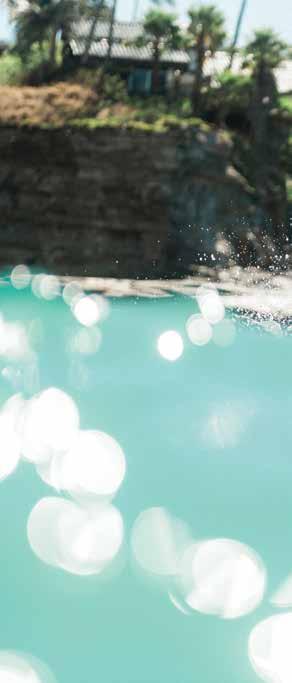

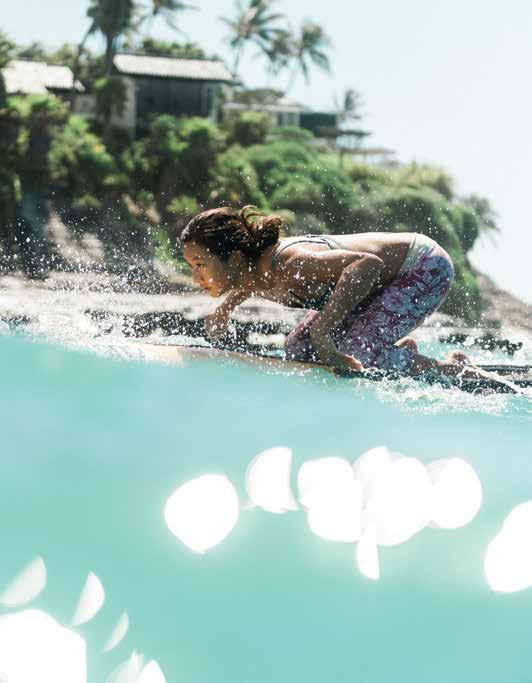
straight to me, as if giving me a path. I grew comfortable in the sea. For the first time in three decades, I finally felt at home in my own body, with the figure I had thought was too skinny, too flat, that looked awkward in a bikini. I grew to love my body and the way it felt in the water. I became the most confident and happy I had ever been.
When people talk about surfing, they speak of its meditative nature and of the healing properties of the ocean. But surfing is also extremely addictive. Maybe, in the end, all things we enjoy become addictions. I couldn’t get enough. I let work and friendships and relationships slide. At first, I loved having this separate world. Then, it became my only world.
I soon found, though, that once I loosened myself from my contracts, the new world that once felt so alluring—the one without the job, the husband, the home—became empty and frightening. I was the child back in the middle of the pool, unable to go forward or back, afraid I would drown. And so, paddling the channel became something to do when I didn’t know what else to do. It became something to define me when I had lost my identity.
Through surfing, I learned the basics of the ocean: tides, swell, wind. Through paddleboarding, I learned its language, by way of intimacy and isolation. There are few places these days where you can surf alone; with paddleboarding, you are often alone. When prone paddleboarding, you lie or kneel on a long, narrow board that’s like a cross between a canoe and surfboard and propel yourself with only your arms. Pulling myself through the water this way feels like crawling across the surface of the sea, giving me time to study the bumps in the water, the curves of the coastline.
On 17-mile training runs from Makai Pier to Kaimana Beach, I observe the water at its moodiest. Around Makapu‘u Point, waves from every direction try to buck me off my board. Here, the water is a deep, dark blue that I want to linger in forever, if I weren’t too afraid of what else lingers there. I know that off the coast of Alan Davis Beach, the waves begin to line up. Delirious laughter escapes me as I find their rhythm. I know that a little farther, past Hanauma Bay, the water will feel violent, crashing against the coast so forcefully I can hear nothing else, but that there may be a little current right along the cliffs that will push me in the direction I want to go. By the time I get to Black Point, the seas are calmer, and the water has a stickiness, as if refusing to let me go. And then, rounding the corner of Diamond Head, I see the lighter blue of Waikīkī, like that of a lover’s eyes, the sign that I am home.
In 2016, I completed my first Moloka‘i-toO‘ahu crossing with a partner who was skilled in the ocean, and was comfortable in the water whether on a surfboard or aboard the Hōkūle‘a . We built our love on the water, and the race was a culmination of our passion. It was an adventure, full of excitement. When we broke up, I thought I was done with paddleboarding, but I found myself signing up for the race the following year, this time with a different partner, who was new to the channel. After a few months of training, I was filled with dread. Preparing for a race is like falling in love: The first time, you revel in the beauty and exhilaration of the experience. The second time around, you know challenges await, and so might heartbreak.
Now in its 22nd year, the Moloka‘i 2 O‘ahu World Championship race is reputed
I continue paddleboarding not because I like suffering and pain, but because I love the ocean, and who I am when I’m in it. It brings to the surface an endurance I didn’t know I had.
�
Martha Cheng writes of a love affair with the water that has both informed and influenced the way she understands herself and her relationships.

to be the most challenging paddleboard event in the world because of its deep and turbulent path. Kaiwi means “the bone,” a reference perhaps to its history of swallowing sailors and spitting up their corpses along the southeast shores of O‘ahu. This is the channel that claimed renowned waterman Eddie Aikau. This is the channel where winds of 30 miles an hour can whip up 20-foot waves. But somewhere between stormy and flat is the sweet spot for paddleboarders.
Every activity has its own way of engaging the ocean, depending on the vessel or purpose. When I am surfing, I love glassy, windless days. But when paddleboarding, I want the wind, which creates waves along the water’s surface that help carry me home. For a race like the Moloka‘i 2 O‘ahu, catching these “bumps” the entire way is ideal—to sprint into the wave, and then relax into it. Sprint, relax, sprint, relax.
Last July, while the elite athletes were nearing the Moloka‘i 2 O‘ahu finish line, breaking records and completing the race in less than five hours, my partner and I struggled as we felt the tide turn, literally. Four hours into the race, it switched and dropped, pushing us away from O‘ahu. I felt my arms and the minutes drag. Yet each time I jumped into the water to switch off with my partner, I let the water close over me, and in the silence and weightlessness of the ocean, I thought, I am lucky to be here. I am happy to be here. Finally,
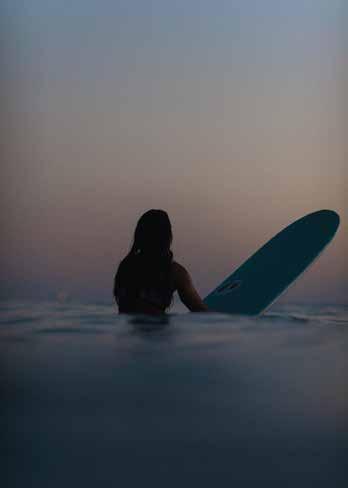
we crossed. It had taken us 7 hours 49 minutes.
I continue paddleboarding not because I like suffering and pain, but because I love the ocean, and who I am when I’m in it. It brings to the surface an endurance I didn’t know I had. It makes things that once seemed insurmountable—like a 10- or even 17-mile paddle—
manageable. For me, it is the disciplined and competitive yang to the carefree and graceful yin of surfing. Each stroke, every time I put my hand in the water, is such a small movement. But together, they have become the parts of me that I like. And that is no small thing.

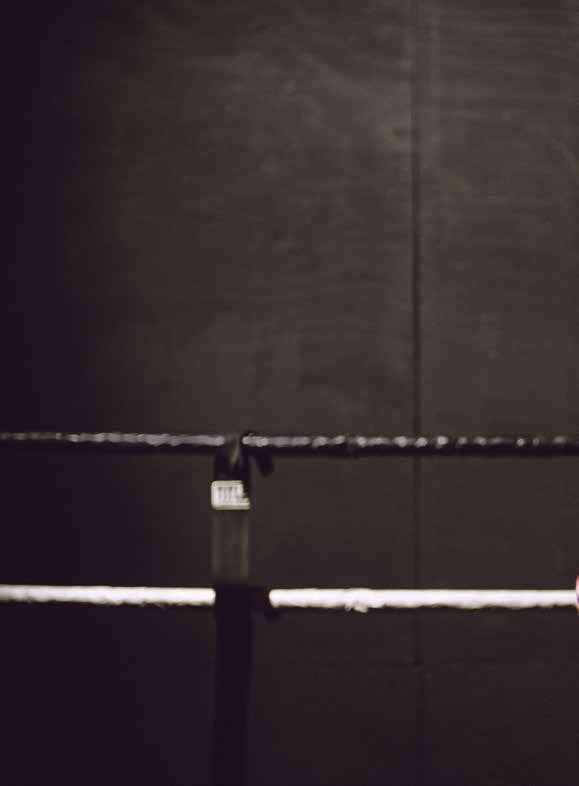
Inspiration strikes in a number of ways. Get in the mindset of a diverse cast of characters to find out what pushes them forward.
TEXT BY RAE SOJOT IMAGES BY JOHN HOOK & LILA LEE

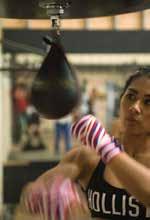

“Boxing is 90 percent mental. You have to be smart and always think ahead.”
In 2014, when Bree Locquiao dropped in on a boxing fitness class at the UFC Gym in Waipahu, boxing instructor Carlos “Nito” Tangaro immediately saw potential in the former collegiate soccer player. Over the next few years, the spry 5-foot1-inch boxing newcomer honed her skills in the ring, becoming a quick study in footwork and combos. In a sport where focus, force, and speed are critical, a strong mind game is tantamount. Her deadly combination of natural athleticism, grit, and discipline resulted in triumph: In 2017, Locquiao became the first female flyweight from Hawaiʻi to be crowned a national Golden Gloves champion.
BREE LOCQUIAO BOXER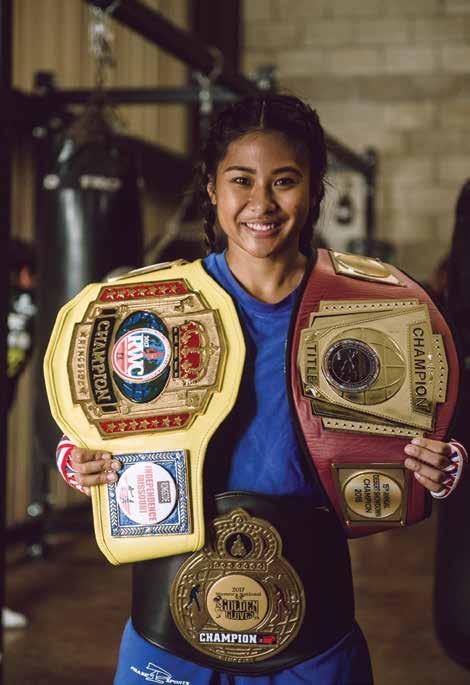



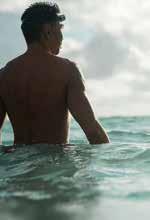

RYAN
“Motion is important to me, not just for my lifestyle, but my life, as well.”
In 2008, triathlete Ryan Leong walked into his doctor’s office for a routine checkup, and walked out with sobering news. Leong, who had heart surgery a decade earlier, was told he had developed “stone heart,” or ischemic myocardial contracture, a rare heart condition in which the pericardium (the sac surrounding the heart) restricts the heart from expanding correctly. So the 45-yearold did what he’s always done: He kept moving. Leong’s affinity for triathlons—specifically, the Ironman races, with their 2.4-mile swims, 112-mile bike rides, and 26.2-mile runs—is eclipsed only by his appetite for the intense, physical training
demanded by them. Through it all, his heart pumps strong. Though doctors suspect that Leong’s robust cardiovascular system staves off his heart’s calcification, Leong remains nonplussed by his diagnosis, preferring instead to focus on the requirements of the sport’s arduous nature: The grind of training is gratifying, and he loves pushing his body to the limit.
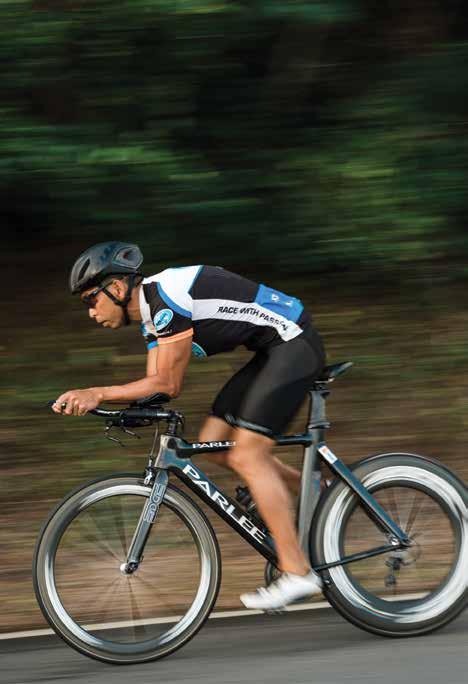




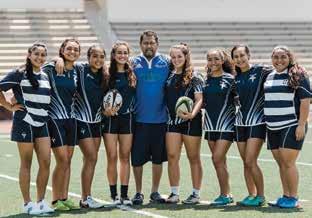
KAMEHAMEHA SCHOOLS ’
K Ā PALAMA HIGH SCHOOL
GIRLS ’ TEAM
RUGBY
“Unlike being hit, to hit someone else feels amazing. If your technique is right, you can stop anybody coming your way.”
On the field, the Kamehameha School’s high school girls’ rugby team is a delightful exercise in cognitive dissonance: a group of teenagers giggling together one moment, and then colliding in brutal, physical combat minutes later. Though naysayers decry the sport as too violent for females, or worse, unladylike, the rugby girls of Kamehameha have found confidence and beauty in the sport’s physicality— running, rucking, scrumming, and tackling. “You may get a couple of bruises on the shoulders or a hit to the face, but nothing is better than preventing a score, and to be honest, taking a girl down to the ground,”
says Cameron Pagador, team captain. No one likes getting hit, the team unanimously agrees (the girls are taught proper response techniques to prevent injury), but hitting an opponent does have a raw, visceral appeal.
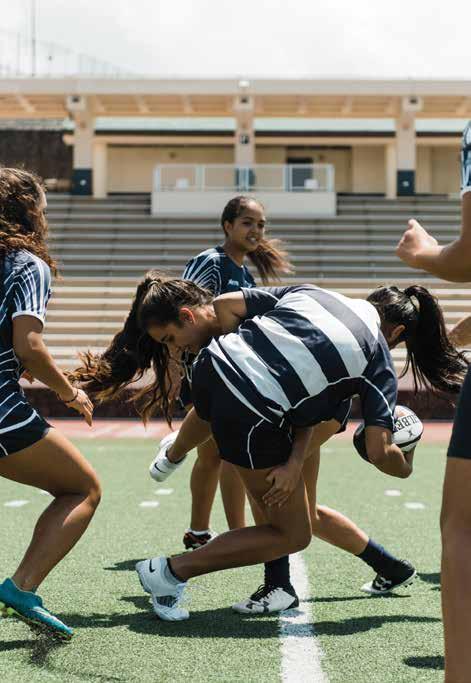
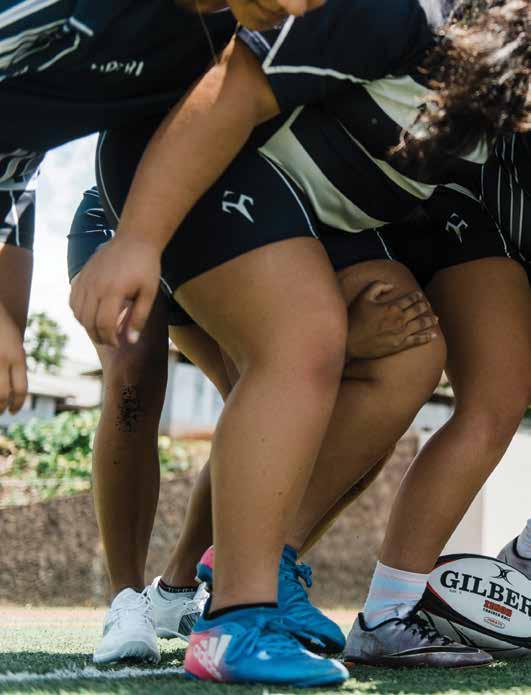


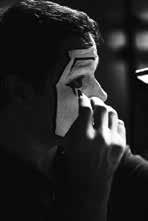

TODDFARLEY MIME
“Through mime I can tell stories that go beyond words, stories that are common to all human beings regardless of culture and language.”
Todd Farley spent his childhood swimming in waterfalls and playing barefoot deep in the rainforests of Hawaiʻi Island. Upon moving to Grandview, Washington at 13 years old, he struggled with mainland speech, manners, and customs. It was the late 1970s and mime was all the rage, recalls Farley. When his church, Grandview Christian Center, started a mime troupe as a form of evangelism, the theatrical art offered a lifeline. For an island-raised boy who spoke Pidgin English, miming was a perfect medium: It required no talking. When he was 17, Farley took his one-man show on the road across the United States, the Bahamas, and Israel, culminating in an invitation to
study under renowned mime artist Marcel Marceau in France. Farley, who has since returned home to Hawai‘i, teaches mime at University of Hawai‘i at Mānoa’s Outreach College, and is working on his opus, a grand retelling of Hawaiʻi Island artist Jerre Tanner’s painting “Boy with Goldfish.”




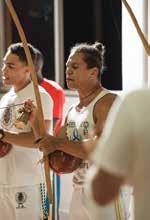

PAULO LINHARES DA SILVA CAPOEIRISTA
“Capoeira is the only martial art where, when you are doing it, you are smiling.”
Paulo Linhares da Silva, better known as Mestre Kinha of Capoeira Besouro Hawaii, grew up in Rio de Janeiro, Brazil, where his parents enrolled him in a capoeira school when he was 7 years old; they were concerned about the violence of the favela in which they lived. The young capoeirista took away more than self-defense, going on to become Rio de Janeiro state capoeira champion in 1991. In 1994, da Silva was given the title of “mestre,” conferred upon those who attain a high level of excellence in the martial art. In accordance with tradition, he chose his nickname, Kinha, to accompany it. Moving to Hawai‘i in 2001,
da Silva brought his love for the sport with him. At his two capoeira academies, on O‘ahu’s east side and in Kaka‘ako, da Silva and his students practice to the upbeat sounds of the berimbau , a musical bow, and the atabaque , a hand drum that keeps the beat. Their swift movements are intensely physical, and the dance-like connections between capoeira players are equally personal. “In capoeira, it is about making the other person feel good,” da Silva says. “You think about the other person and make them feel comfortable. When you finish, you then feel proud about yourself and you feel happy toward your partner.”
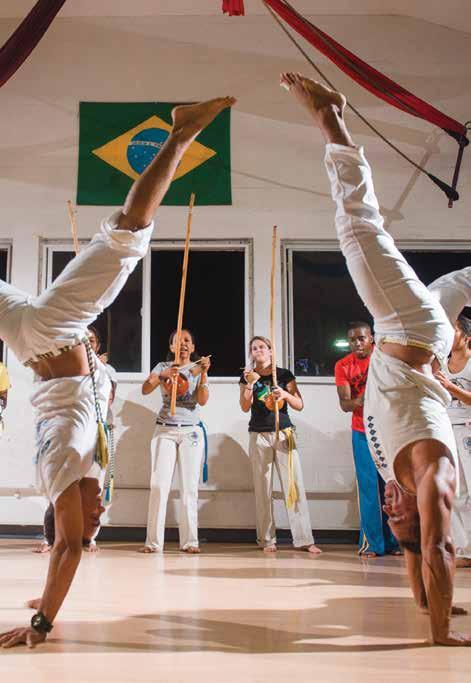

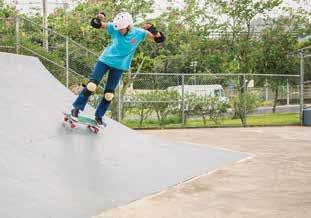
JACKIEGRAESSLE SKATEBOARDER
“Skateboarding juxtaposes joy and peril, and therein lies its attraction for me.”
Jackie Graessle’s sunny disposition extends to her outlook on learning new skills. After watching (and rewatching, at least 30 times) Dogtown and Z-Boys , a 2001 documentary featuring a rag-tag collection of gritty Venice Beach street urchins who revolutionized skateboarding in the 1970s, Graessle, a social worker, was inspired by the sport’s subculture spirit. She decided that she wanted in. She was 62 years old. “I just see it and think I can do it,” says Graessle, a year later. Enlisting the help of Nainoa Andrade, a local skate instructor she procured online, Graessle finds joie de vivre via deck, trucks, and wheels. “I feel a profound
sense of exhilaration when I am in the moment, flying along,” Graessle says. At her home park in Kāne‘ohe, where she skates four times a week, she has also found a tribe of fellow skaters who share her sentiment: Stoke knows no age.

FLUX FEATURE
Two printmakers, Charles Cohan and Abigail Romanchak, teacher and student in no particular order, recount the path that led to their past and upcoming collaborations.
TEXT BY ABIGAIL ROMANCHAK & CHARLES COHANCOHAN IMAGES BY JONEL JUGETA ROMANCHAK IMAGES BY JOSE MORALES
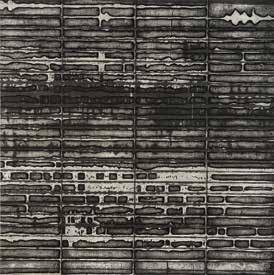

ON CONVERGENCE:
� Charles Cohan: In 1952, Carl Jung published Synchronizität als ein Prinzip akausaler Zusammenhänge, or Synchronicity: An Acausal Connecting Principle, which states that events are “meaningful coincidences” if they occur with no causal logic, yet are meaningfully related. A favorite and enduring example of this phenomenon in the arts refers to the invention of photography in the 1830s, when unbeknownst to each other, Louis Daguerre was doing research in France that coincided with the experiments of Henry Fox Talbot in England.
The most profound example of this occurrence in my personal experience took place at noon on May 3, 2017, when Abigail Romanchak sent me a set of images that were eerily simultaneous to a body of work that I was developing. Through immediate phone calls, texts, and emails, it became clear that we were traveling a common path in our creative directions. Thus, the 9-foot by 20-foot print installation Converge , our collaboration for Ground , my solo exhibition at the Honolulu Museum of Art, was born.
� Abigail Romanchak: Reflecting on these collaborations with Charles Cohan, my former printmaking professor, brings to mind an interview I heard on Krista Tippett’s podcast, “On Being.” The guest was author Elizabeth Gilbert. At one point, Gilbert recounted a time she and another writer, Ann Patchett, had the exact same idea for a novel without even knowing it. Gilbert then described how she believes ideas are conscious, living things,
which possess a great desire to be manifested, and that they spin through the cosmos looking for human collaborators.
At the time, I thought this sounded wonky. But then, I had a very similar experience. In April 2017 I was invited to be part of a Smithsonian-sponsored pop-up culture lab in Honolulu. For it, artists were asked to respond to the concept of ‘ae kai, or convergence of land and water. I interpreted this theme quite literally, and decided to work with seismograph readings and harmonic tremor printouts from Kīlauea Volcano on Hawai‘i Island. I wanted to explore how the origins of new land converge with existing coastal landscapes. But as I began to carve, I realized that these intricate, large-scale woodcuts would pose too great a technical challenge for me to tackle on my own. So I emailed Charlie images of the carvings I had worked on, and asked if he would assist me. To my surprise, I received a call from him within 10 minutes of hitting the send button. “Abbey! You’re not going to believe how similar my new body of work is to the seismograph images you just emailed me,” he said. He agreed to help print the woodcuts, and asked to talk soon about a future collaboration.
� Cohan: Since my arrival at the University of Hawai‘i at Mānoa in August of 1994, I have worked with more than 1,000 undergraduate and 25 MFA students in the printmaking studios of the department of art and art history. Abigail Romanchak is one of a few of my former students who have provided the most significant
contributions to the identity and culture of the printmaking program. Abbey and I have shared four stages in our artistic relationship. First, I was her professor as she earned her BFA and MFA degrees. We were then fellow printmakers, before working together as collaborators. Now, Abbey has transcended the student-teacher duality, overturning this paradigm into the full cycle of teacher as student, student as teacher, exposing the power of this dichotomy and its inversion. Qualities of weight, density, texture, and the indelibility of the printed mark remain a shared aspect of our work. The visceral approach that we take, conveyed through the transfer of ink from plate to paper via sheer pressure, is a thread that ties together our collective graphic sense.
� Romanchak: Charlie remains youthfully enthusiastic and open, despite his high level of success and sophistication. He is a worldrenowned artist—idolized by his students and highly respected by his colleagues—who enjoys skateboarding with his son. I was grateful for his help, and humbled by the invitation to collaborate. Yet, I was also ambivalent. Creating as a team would be difficult with anyone, let alone my mentor. Could we really work on equal terms? What could I contribute to the process when he was used to hand-carving his own doorsize wood cuts, perfectly registering a 20-color screen print, and building his own custom frames?
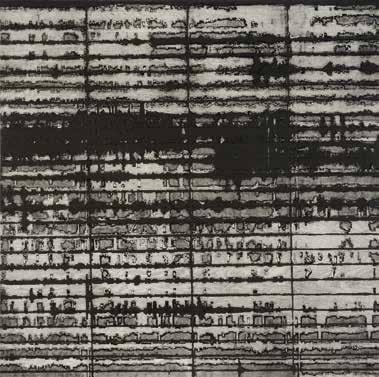 Converge , Abigail Romanchak.
Converge , Abigail Romanchak.
� Cohan: My prints in the Converge and Ground series are carborundum and glue collagraphs. The collagraph process was mutually invented by a few printmakers during the 1970s print culture in the United States, including Edward Stasack and Lee Chesney, who were UH Mānoa printmaking professors at the time. Collagraphs are prints made using a collage-based process of attaching physical textures in a range of materials to the printing plate with various varnishes and adhesives.
� Romanchak: To make my Converge prints, I traced images of seismograph readings onto five different sheets of 30-inch by 30-inch birch plywood. Then, using a variety of tools, I carved away the negative space. In June 2017, Charlie flew from O‘ahu to the Hui No‘eau Visual Art Center printmaking studio on Maui to help me print my work for ‘Ae Kai , the exhibition put on in July by the Smithsonian Asian Pacific American Center, and Ground , Charlie’s solo exhibition at the Honolulu Museum of Art, for which we are collaborating on the Converge installation. Due to the size and intricacy of my carved woodcuts, it was most helpful to have an extra set of hands applying ink, wiping, and printing the woodcuts. While in the studio together, we pinned up our finished prints, imagining how they might look tiled
next to each other in ‘Ae Kai . A month later, I flew from Maui to O‘ahu with 20 different 30-inch by 30-inch prints. The day before the opening of the ‘Ae Kai exhibit, Charlie and I spent an afternoon together in an empty art studio at UH Mānoa rearranging our prints on the ground, until we were satisfied with a final composition for our 9-foot by 20-foot installation.
� Cohan: Twenty years into our relationship, I am increasingly inspired by Abbey’s commitment to the issues particular to Hawai‘i, the relevance her work has acquired in the Hawaiian cultural community, and her evolving recognition as one of Hawai‘i’s most important visual artists. We celebrate our mutual connection to volcanic formation, earth movement, the creation of landmass, and the existence of islands and mountains in general. For Abbey, this is the Hawaiian Island chain. For me, it is the Cascade Mountains of the Pacific Northwest. Inspired by these two locations, the collaborations presented in ‘Ae Kai and Ground attempt to graphically translate the forces of geophysical change, including sedimentary compression, geologic weight, and the occurrences of seepage, fracturing, slippage, failure, and layering: the geothermal and hydraulic meeting of rock and water; fluid or frozen, hot or cold.
� Romanchak: Our collaboration for ‘Ae Kai was influenced by the continuous breathing of a volcano. My prints drew from the sustained release of seismic energy typically associated with the underground movement of magma, while Charlie’s prints referenced a graphic reverb of the movement of ground. I am still awed that Charlie and I had such similar concepts at the same time, and that our prints came together so seamlessly. I like to think our ideas weren’t really ours, after all, but had been spinning through the cosmos, looking for someone to express them, when they found us.
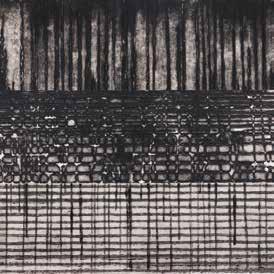
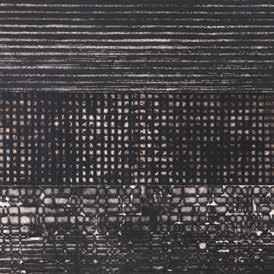
Converge II , installation detail, Charles Cohan.
 � Stephen Bruner, the artist better known as Thundercat. Image courtesy of Thundercat.
� Stephen Bruner, the artist better known as Thundercat. Image courtesy of Thundercat.

“Surf the cosmos. Smell the space dust. Find your way home.”—Thundercat, lyrics from “Song for the Dead,” from The Beyond/Where the Giants Roam

Brought to you by The Modern Honolulu
FLUX Sound spotlights Hawai‘i’s sonic talents, delving into what makes Hawai‘i music the most unique in the world.
For its inaugural event, a two-day talk story and concert on the grounds of The Modern Honolulu, FLUX brings Thundercat to Honolulu. The Grammy Award-winning artist will take the stage with local musicians Izik, Aloha Got Soul, Front Business, and more, in an experience that fosters cultural connections among global and local musicians.
FLUX Sound is in partnership with:
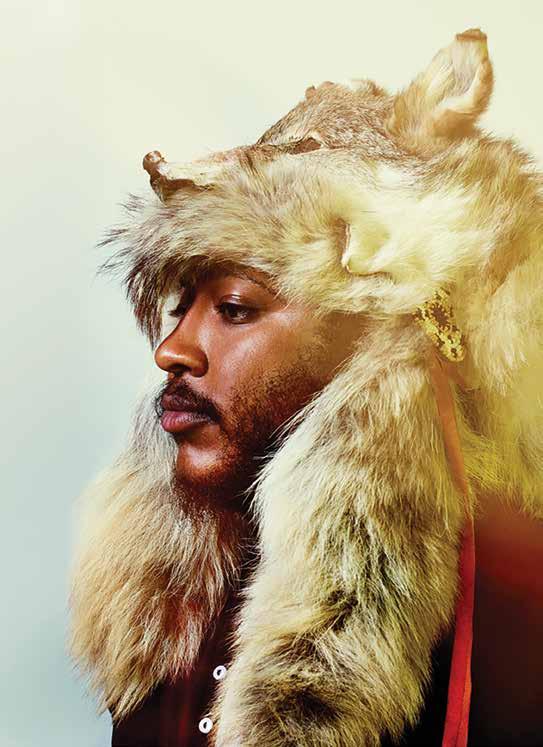



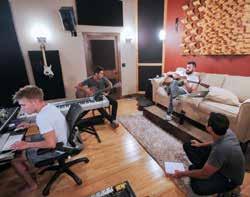
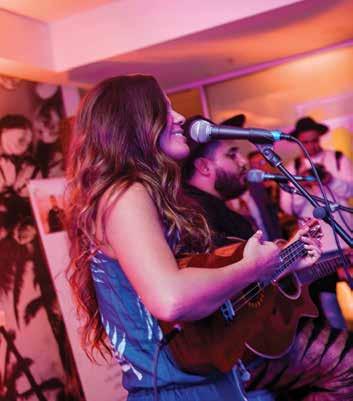
Offering immersive programs, workshops, public panels and mentorship by creative industry leaders from across the globe.

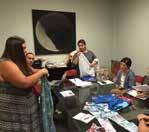
For more information visit cid.hawaii.gov or creativelab.hawaii.gov. @CreativeLabHI @creativeHI808
The Creative Lab Hawai‘i Music Immersive helps artists realize their full potentials and attain success in the music industry.
TEXT BY EUNICA ESCALANTE IMAGES BY MEGAN SPELMANThe strumming of a bass guitar broke the silence of the Doris Duke Theatre, followed by the steady pulse of the drums and the plucking of a guitar. Then Isaac Moreno, the musician known as Izik, stepped up to the microphone and hummed an opening note. His voice, deep and soulful, filled the cavernous theater. By the end of the song—a pop-infused

rumination on a past romance—Moreno had the crowd under his spell.
Comprised of four acts, with a flourish of costume changes in between each, the show, which Izik titled Mimesis , fell somewhere between concert and performance art, and displayed the singer as a charismatic performer whose artistry is bigger than the stages that hold him. Yet, just a year ago, in 2016, the Molokaʻi born and Oʻahu raised artist was far from this stage, gigging nearly every night at a bar or hotel, sometimes even playing two three-hour sets in a row. All of this was done in pursuit of a music career—a dream Moreno has had since the age of 4, when he would match pitch with his mother’s vacuum cleaner. For him and many other Hawaiʻibased artists, Moreno said, this rigorous lineup of gigs seemed to be the only path to success.
Then, at the behest of fellow musician Kimié Miner, Moreno applied for, and was accepted to, the Creative Lab Hawai‘i Music Immersive, a program that aims to set up island musicians for success, teaching them the finer points of topics like songwriting, music
� For more information, or to apply for the 2018 Creative Lab Hawaii Music Immersive in early 2018, visit creativelab.hawaii.gov.

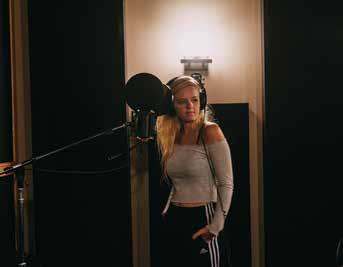
licensing, publishing, and intellectual property protection. Created by the Department of Business, Economic Development and Tourism’s Creative Industries Division (CID)—an agency that advocates for and accelerates the growth of Hawai‘i’s creative clusters, including music, film, design, and technology—the Creative Lab Hawai‘i Music Immersive is overseen by program director Charles Brotman, a Nā Hōkū Hanohano and Grammy Award-winning producer and president of the Hawaiʻi Songwriting Festival. “Our community of music and media entrepreneurs need access to decision makers to expand their opportunities to export globally,” says Georja Skinner, chief officer of Creative Industries and founder of Creative Lab Hawai‘i. “The synergies with Hawai‘i Songwriting Festival, and with Charles and Julia Brotman at the helm, provided the rich foundation to grow this vision.”
Together with the CID team, Brotman was selected to manage the intensive program, which aimed to bridge the gap between emerging artists and industry professionals. They began working with the late Jerome Spence, then the vice president of film, television, advertisement, and business development at the Los Angeles-based licensing and artist management company, Secret Road Music Services. Thus, and the Creative Lab Hawai‘i Music Immersive was born.
Kicking off with a five-day immersive, held at the Hapuna Beach Prince Hotel and at music studios on Hawai‘i Island, Moreno, along with nine other participating musicians, collaborated with professional songwriters, producers, and music executives from the mainland. As with Creative Lab Hawai‘i ’s media and fashion immersives, the music program continued for a full year, with
participants receiving regular coaching.
Within a year of taking part in the immersive, Moreno had licensed two original songs to a major entertainment corporation, giving him the economic flexibility to focus on his art. He cut down his performances from seven nights to a couple of times a week. He, along with Miner, travelled to Los Angeles, New York, and Australia to perform as part of the Creative Lab Hawai‘i Music Immersive’s goal to expose new markets to Hawai‘i’s creative talents. Now, he is even working on his second album and will open for Grammy Award-winning Thundercat as part of FLUX Sound, a music experience made possible with the support of DBEDT and taking place at the Modern Honolulu in December 2017.
For Miner, the program planted a seed for her to found a new company, Haku Hawai‘i. “Through this experience, I started thinking about

mentorships programs that I have been involved with,” she says. “After the Creative Lab Music Immersive, I realized I could take all the tools and the connections that I made through the program and combine all of us together to create this new sound for Hawai‘i.”
In August 2017, Moreno and Miner returned to the Creative Lab Hawai‘i Music Immersive, but this time to mentor a new cohort of aspiring musicians. The musicians that took part in this year’s immersive include folk trio Streelight Cadence; singer-songwriter Amanda Frazier; 15-year old multi-instrumentalist Olivia Cargile; songwriter and producer Josh Jones; pop-folk artist Kimberly June; brothers Chase and Carl Kauhane; singersongwriter Keilana Mokulehua; soulful songwriter Tim Rose; Nā Hōkū Hanohano Award-winning songwriter Chaz Umamoto; and Los Angeles-based Zoe Zelkind.
For Frazier, the direct connection to industry executives was invaluable. “I’ve been doing songwriting for ten years, but I’ve never had this kind of experience,”
she says. “People in Hawai‘i, we have the passion, we have the talent, we have the drive, but we don’t necessarily have the tools or the opportunity to engage with those with such expertise. … To bring people from the mainland, the outer islands, it’s such a unique opportunity that without the state stepping in and helping, it might not ever have been something we could have experienced.”
Streetlight Cadence discovered the Music Immersive at last year’s Hawaiʻi Songwriting Festival, intrigued by its intimate group of music industry professionals. The band began as streetperformers and built a fanbase through their charismatic performances and unique sound. “In the practical sense, we didn’t have an outlet to develop a music career other than what we could do by ourselves,” says violinist Jonathan Franklin. “Suddenly, by taking part in this immersive, we have a new resource that opens up doors for us in all aspects of the music industry. The program has played such an integral role in our development as a band.
� Streetlight Cadence band members, from left to right, are Brian Webb, Jonathon Franklin, and Jesse Shiroma.
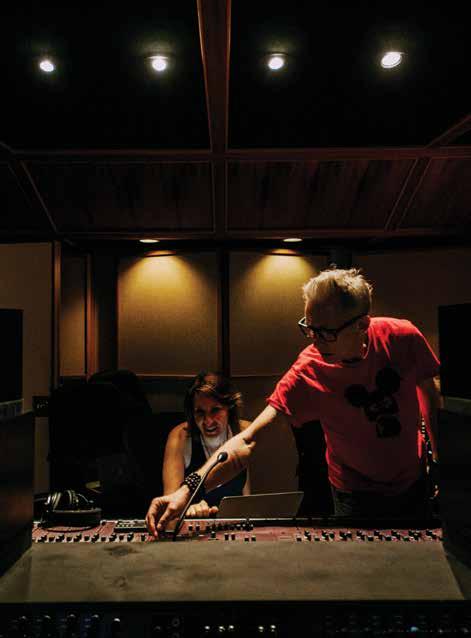 � Participating attendees are coached by professionals in the music industry.
� Participating attendees are coached by professionals in the music industry.
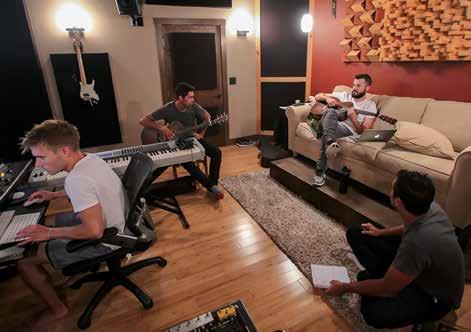
From early in the morning until late at night, the participants were immersed in a constant flow of conceptualizing, songwriting, recording, and producing. They labored over songs based on prompts delivered by music executives like Boyd and Mamie Coleman, senior vice president of creative music and production at Fox. One prompt called for crafting a theme song for a hit television show, while another requested a tune for a commercial featuring a major cellular phone company.
The prompts reflect the industry’s demands for original music. “For young musicians in Hawai‘i, a lot of them think that their options are limited–they can play in a hotel or they can go to Japan,” Brotman says. “But there are so many more options available. The Creative Lab Hawai‘i Music Immersive aims to create awareness for musicians, teaching them about the business side of the industry and letting them know of careers beyond cycles of gigs.”
In addition to introducing aspiring artists to music licensing, the program serves as a link between Hawai‘i’s music community
and industries around the globe. Last year, three original songs created during the program were sold to a major entertainment company, two were licensed to a major cable network, and two were licensed for yearlong advertising campaigns.
For Secret Road founder, Lynn Grossman—whose company manages all the licensing of the music created during the program—mentorship is a crucial aspect of an artist’s success. “The immersive sharpened our skills,” says Streetlight Cadence accordionist Jesse Shiroma. “I can write songs—it’s verse, pre-chorus, and chorus—but you can’t just write blockbuster hits. You have to know what music executives want. … Even if you write 100 songs, you can put them out into the web, and hope that somebody picks you up. But the immersive puts you in hand-tohand, eye-to-eye contact with the people who want to place your music. I don’t know of any other thing that does this besides the immersive.”
as

�
across genres collaborate to produce original
Musicians works. Above, Streetlight Cadence joined by musician Keilana Mokulehua and producer Adam Zelkind.Beneath the sweet strings and harmonies of modern Hawaiian music lie complex compositions that are laced with hidden messages and political sway.
TEXT BY TRAVIS HANCOCK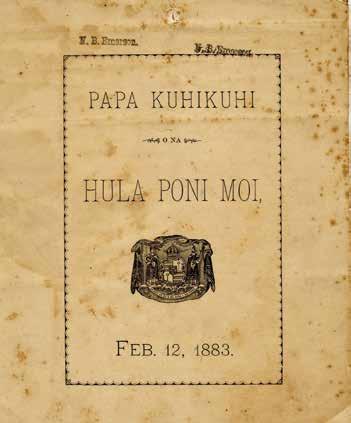
On a Sunday in June, I took a drive out to O‘ahu’s North Shore. As I passed Dole Plantation, radio static started to consume the airwaves, until just two stations were left HPR’s “Kanikapila Sunday” show and KTUH’s “Kīpuka Leo.” While I appreciated the beautiful Hawaiian melodies coming through the speakers, as a nonHawaiian speaker, I failed to grasp most of the lyrics. I flipped between the stations, trying to isolate words, and then I noticed a brief phrase repeated again and again: “ka puana.” As I listened closer, I found it appeared in almost every Hawaiian song.
“Puana,” I learned, is the summary refrain, theme, or beginning of a song. To sing the word is to call for a return to that note or line, or to simply begin.
� The original program for King Kal ā kaua’s coronation, the most regal music and hula event of 19th century Hawai‘i.
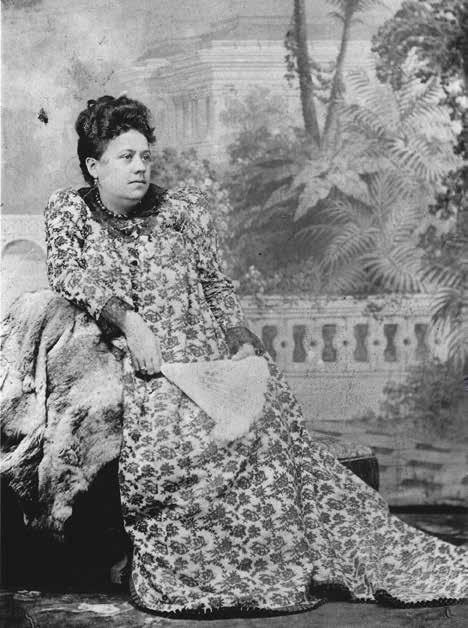 � Eleanor Kekoaohiwaikalani Wright Prendergast, close friend and lady-in-waiting to Queen Lili‘uokalani, was a haku mele (composer) of famed Hawaiian songs such as “Kaulana Nā Pua.”
� Eleanor Kekoaohiwaikalani Wright Prendergast, close friend and lady-in-waiting to Queen Lili‘uokalani, was a haku mele (composer) of famed Hawaiian songs such as “Kaulana Nā Pua.”
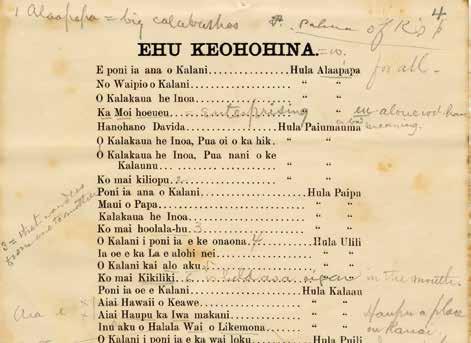
This gesture reminded me of learning dances for May Day in elementary, the kumu calling out moves ahead of the song’s next lines. “OK, now do the ‘ami!” she would say, and we would rotate our little hips to the next line.
I sought out an expert to confirm my hunch that “ka puana” was linked to hula and was connected with Hawaiian musician and educator Aaron Salā. He explained the recurrence of “ka puana” indeed goes back to a performance style called hula kuʻi, which came into existence after Western contact and uses postcontact elements like the Western diatonic scale and modern stringed instruments. Salā said, “The last verse of a hula kuʻi song, regardless of the length of the song itself, is signaled by the haʻina,” a call to sing the song’s puana.
In her book, Aloha Betrayed , Hawaiian scholar Noenoe Silva states that hula kuʻi goes back to February
1883, when King Kalākaua held his month-long coronation ceremony, which was eight years overdue. To properly celebrate, Kalākaua, known as the Merrie Monarch, ordered the printing of Papa Kuhikuhi o Na Hula Poni Moi a program of oli, mele, and hula to be distributed ahead of the event. The schedule included hula ma‘i performances, an older style of dance often associated with procreation, as well as the formal debut of hula kuʻi, which was, according to Hawaiian music scholar Amy Stillman, “a vehicle for reinforcing Hawaiian pride and being Hawaiian and also for validating Kalākaua’s right to rule.”
However, the promotion of such hula seemed risky to The Hawaiian Gazette, a haole-owned newspaper, which predicted that “the law of the land may be broken.” The law in question was a carryover from the 1830 ban on hula urged by puritanical American missionaries. “[Their descendants] denounced the program as obscene, as well as illegal under the statute against public nuisances,” Silva writes. These self-appointed censors were especially bothered by the inclusion of hula ma‘i. Lawyer and legislator William R. Castle went so far as to have the document’s printers arrested.
But with Kalākaua’s defiant blessing, the program proceeded. The event reinvigorated hula and mele production, as well as the use of kaona, or hidden meanings, which abound in hula kuʻi compositions. The kaona tradition is thriving in the music of modern haku mele (composers), like performer Chad Takatsugi and lyricist Kahikina de Silva, who collaborated on the song “He Wehi No Pauahi,” which won the 2016 Nā Hōkū Hanohano Haku Mele Award.
The mele honors Hawaiian princess Bernice Pauahi Bishop and demonstrates how kaona can

� Pages from the program for Papa Kuhikuhi o Na Hula Poni Moi.

be reinforced by the puana. In the penultimate verse, de Silva alludes to the tradition of bringing roses to Pauahi’s tomb on her birthday, and then declares her as “a queen in my eyes / working for the pono of our lāhui.” This kaona-rich line can mean “the good of our people” and “the right of our nation.” This leads into the puana, which enshrines Pauahi as a lei of roses. Like a lei-maker looping the thread back through the same flower, de Silva repeats the image of the rose to strengthen the impact of the lines between them, and the kaona they confer a lamentation for a queen that never was, and an assertion of the royal’s lasting power. Wordplay like this is a given for Takatsugi. “In one moment, you could hear a composition of a dew-kissed lehua blossom representing the composer’s loved one, and the next moment you could hear about the steamships going between the islands,
and in yet another moment you could hear about political turmoil at the turn of the century,” he explains. “It was a common practice to use the imagery of a storm to represent political turmoil, or to refer to people as ‘pua kaulana aʻo Hawaiʻi,’ or ‘proud flowers of Hawaiʻi.’”
Such is the case in the popular song “Kaulana Nā Pua,” written by Eleanor Kekoaohiwaikalani Wright Prendergast, a late-19th-century haku mele for the Royal Hawaiian Band. But few non-Hawaiian speakers realize that the hula kuʻi-style song, written in 1893, was a thinly veiled protest of Queen Liliʻuokalani’s overthrow. In translation, Prendergast tells of the flowers of Hawai‘i famous for their loyalty when “wicked delegates come with documents to cheat them.” The song offers overt support for Liliʻuokalani and ends, “Haʻina ʻia mai ana ka puana / Ka poʻe i aloha i ka ʻāina.” Translation:
“Tell the story / Of the people who love their land.” Neatly ordered into strophic four-line verses and a choral refrain the puana these messages of hope and solidarity, unbeknownst to the oppressors, rode across the airwaves of the new Republic as if within a Trojan horse.
“Some of the most poignant and profound compositions have six to eight words in an entire verse,” Takatsugi says. “Someone who is listening with context and intent will hear the volumes of sublevel text that those six to eight words carry with them.” This understanding can start with a single word, which, like a single flower in a lei, loops you into a blossoming continuum playing every Sunday, when all the rest is static.
Oʻahu’s long-gone recording studios echo an industry that captured Hawai‘i’s identity.
TEXT AND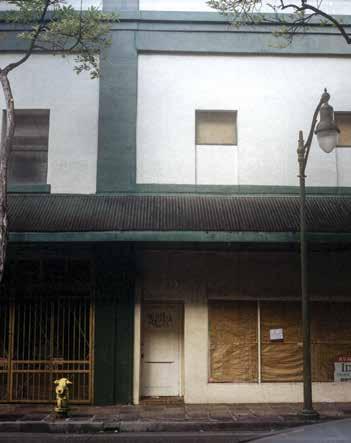
There’s no doubt that the physical landscape of our city is changing. Rapid transit’s concrete pillars and platforms stretch across O‘ahu’s horizon. Glass-paned buildings replace older structures throughout Ala Moana, Ward, and Kaka‘ako, claiming more space in our skies each year. What this means for Honolulu, we have yet to find out. But it begs us to consider what we might end up losing.
Digital technology similarly disrupted the music recording industry in the 1980s. “A million dollar studio in the ’80s is realized today within a desktop computer,” says Honolulu recording
� Broad Recording Studio, 1976–early 1980s. The space is currently for lease.
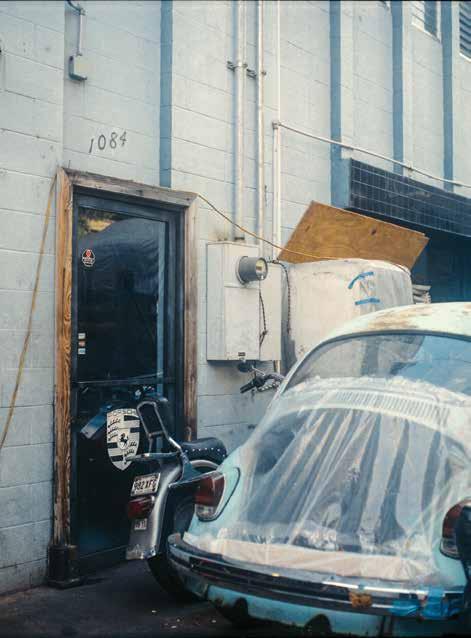 � Sounds of Hawaii, 1962–1990s. Now an independently owned Porsche repair shop.
� Sounds of Hawaii, 1962–1990s. Now an independently owned Porsche repair shop.
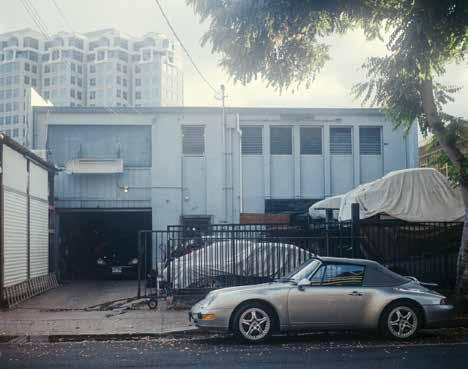
engineer Wayne Carvalho, who worked at Sinergia Recording Studios when it was on Waimanu Street in Kaka‘ako, and later, in Kāne‘ohe. Coupled with the power of the Internet, a computer eliminates the need for a shared space for people to gather to create and record music. Instead, everything can be done digitally, from the tracking of virtual instruments to collaborating with talented musicians across the globe.
This means there are no limits to the projects we can pursue. Forty years ago, you needed a budget for studio time, musicians, reels of recording tape, mastering, and manufacturing vinyl records. Now, all the digital parallels can be done on a laptop over the weekend, with the results streaming on Spotify by Monday.
Donn Tyler, owner of Commercial Recording Studio, recorded slack key guitarist Gabby Pahinui’s Gabby album, known as the “brown album” by collectors
because of the earthy color of its album art, at his former studio in Kakaʻako. Because Pahinui and his three sons had to see each other when playing, Tyler placed them in a circle and constructed sound baffles around each musician, so that one person’s sound would not leak into the other person’s microphone. “The baffles were just high enough so they could see each other, and they each had on one headphone so they could hear each other,” Tyler recalls. The music for the album wasn’t written in advance, so they depended on a shared space like Tyler’s to create what is now one of Hawai‘i’s most celebrated recordings of the 20th century.
Commercial Recording Studio, along with Sounds of Hawaii, Audio Media, Audissey, Sinergia Recording Studios, and Broad Recording Studio helped preserve Hawai‘i’s musical palette for future generations. Though all of these are no longer in operation today, they mark sonic

� Audissey, 1970s–present. It is currently at SALT at Kaka‘ako, a mixed-used development, but with no recording capabilities.
landmarks of Hawai‘i’s past. Gordon Broad was once the co-owner of Broad Recording Studio in Chinatown, where contemporary artists like Lemuria, Aura, Phase 7, Momi Riley, and Mike Lundy once recorded. Though the sound is going to change, because it’s analog, Broad says that what makes a recording studio special is that “it takes skill to anticipate the end result.”
With technology comes progress, but progress can also alter who we are and how we interact. It’s difficult to say what will happen when our musical landmarks—once guards of Hawai‘i’s auditory identity—fade, but we must continually keep our eyes, and our ears, open.
� Right: Audio Media, 1979–2009. Currently Studio Ala Moana, a recording studio. Opposite: Commercial Recording Studio, 1965–1997. Currently a Porsche of Hawaii service warehouse.
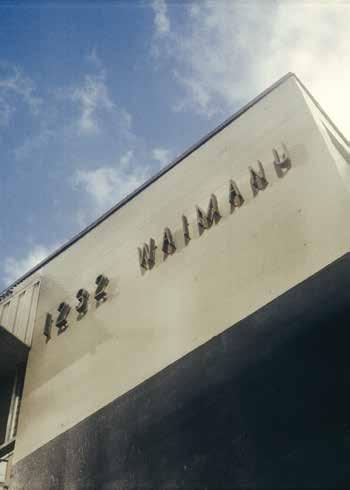

In the digital age, concerts remain a powerful way to connect to bands and each other.
TEXT BY NAZARETH KAWAKAMI IMAGES BY MICHAEL KEANYWhen I was 13 years old, I used a handful of quarters to pay my way into Coffee Talk to see a little-known punk band from Seattle. The lead singer screamed words into a microphone, flailing his arms and jumping from a barstool into a sea of hands barely ready to catch him. Waiting to hear what this band would come up with next gave me a feeling of

nervous anticipation. That night in 2007, I fell in love with the raw, unfiltered energy that filled and spun around the room. I grew up craving that energy again, saving any dollar I could for concert tickets and CDs.
Today, such experiences occur as quickly as one can type, and at little to no cost. Through social media, and on music apps like Pandora and Spotify, listeners can discover new music the moment it’s released. Although this aspect of the digital age has helped new artists gain exposure on a large scale, it has also squeezed the live music experience. Josh Hancock, the frontman for Hawai‘i bands 86 List and Black Square, and a promoter in the Honolulu music scene for the better part of two decades, has seen this directly. Before the tides changed, “We would wait weeks, sometimes months, to see a band play and be so psyched about it,” Hancock says. “Going to the show now, you’re seeing something you could tap into at any time.”
Despite the change in listening habits, Hawai‘i’s
� Harshist, 2012. “You can stream a performance online,” BAMP partner Philip Pendleton says, “but it’s not the same as when you’re at a concert, standing in a room full of people where everyone shares one common interest—the band you’re waiting to see.”
 � Live performances by artists, either locally and internationally known, collectively electrify the Chinatown music scene.
� Live performances by artists, either locally and internationally known, collectively electrify the Chinatown music scene.
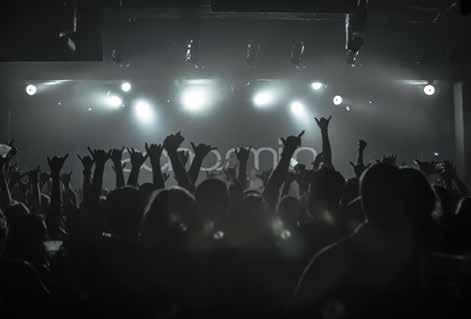
music community remains committed to providing opportunities to experience live music. On any given night, one can find live performances in Honolulu, from jazz at Lewers Lounge to reggae at Mai Tai Bar to punk rock at Downbeat Lounge or Hawaiian Brian’s.
“Music, especially live music, is important for people,” says Philip Pendleton, co-founder of BAMP Projects, one of the largest concert promotion companies in the state. “I went to a lot of live shows growing up, and I think it’s important for people to experience that. … You can stream a performance online, but it’s not the same as when you’re at a concert, standing in a room full of people where everyone shares one common interest—the band you’re waiting to see.”
Along with partner Matty Hazelgrove, Pendleton has been bringing live shows to Hawai‘i with BAMP for the last decade. In 2006, for BAMP’s first promotion, they had a wildly successful concert with Steel Pulse at the Waikiki Shell, selling 4,000 tickets the day of the show. From this, Pendleton and his partners realized the hunger island
residents have for live music. They brought out Hawthorne Heights a short while later, and after their set, Pendleton recalls the band remarking that it was the best show they had ever played, second only to their hometown crowd. “And that happened for years,” Pendleton says. “People were crowd surfing at Deathcab for Cutie in 2012. People hadn’t crowd-surfed at a Deathcab for Cutie show in like a decade.”
BAMP Projects programs nearly 100 shows per year, oftentimes at the Republik, a venue it acquired in 2012. Its concerts have included a wide range of artists, from legacy acts, such as Tony Bennett and The Cure, to chart-toppers like Chance the Rapper and indie bands like Toro y Moi. Concerts, Pendleton says, are important because they yank us from virtual worlds and connect us to each other. Hancock agrees. “You can hear a studio track, or watch a live recording on YouTube, but it’s not like being there in that moment,” he says. “It can’t replace the raw energy, that feeling you get when you’re watching it all happen.”




Eight years and four albums later, The Green continues to broadcast its island vibes and aloha spirit across the country.
TEXT BY AJA TOSCANO

You can’t see the beach from the urban Kalihi studio space where The Green practices, but the band’s brassy, bouncy melodies are enough to transport you there. The six-piece Oʻahu band, comprised of lead vocalist Caleb Keolanui, guitarists JP Kennedy and Zion Thompson, keyboardist Ikaika Antone, bassist Brad Watanabe, and drummer Jordan Espinoza, unbox their instruments, tune their strings, and run through a few vocal harmonies. It’s jamming time.
Since 2009, The Green has been spreading feel-good musical vibes throughout its island home and beyond. This January, the group will tour its recently released album, Marching Orders , on a cross-
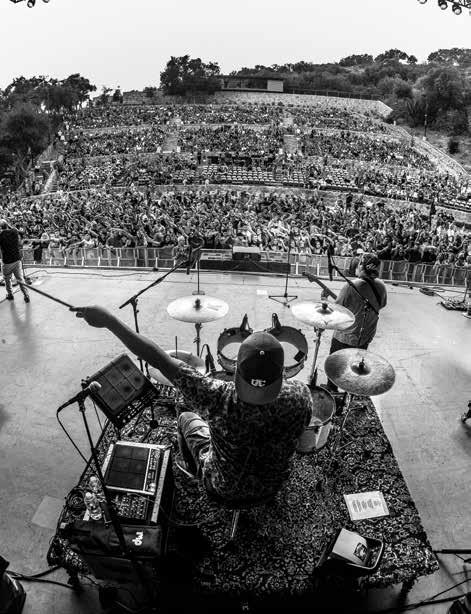
� The Green’s brand of island-inspired music sells out arenas nationwide. The band includes lead vocalist Caleb Keolanui, guitarists JP Kennedy and Zion Thompson, keyboardist Ikaika Antone, bassist Brad Watanabe, and drummer Jordan Espinoza.

country, multi-city scale. With hardly more than a 24-hour break scheduled between sets, the demanding upcoming schedule illustrates how seasoned the bandmates have become since their humble beginnings as a group nearly a decade ago.
Before forming The Green, each member’s social circles already overlapped—Keolanui and Kennedy are cousins, and the rest all came of age in Kailua or Hawai‘i Kai. When Keolanui and Kennedy set out to form the band, they called on high school friends Antone and Thompson. They have had their tunnel vision on The Green ever since.
Now the band is all grown up, its shows selling out to a devout fan base across the continental United States. “At this point in our career, we’re reaching the years that are really going to define us as a group,” Kennedy says. The Green’s latest
output, Marching Orders , is the band’s most mature work to date, continuing the stirring fusion sound that pushes beyond the confines of contemporary Jawaiian, a blending of Jamaican reggae with Hawaiian styles.
“We don’t like to use the term ‘Jawaiian,’” says Antone, of The Green’s sound. “It was definitely an influence on us. Everyone in Hawaiʻi grew up listening to that music—you can’t avoid it here.” While he cites seminal Jawaiian groups like Steel Pulse as inspirations, he also gives examples of curveball influences, from rap to country. “I think Hawaiʻi has its own brand of reggae, and it’s surpassed [Jawaiian] with the amount of experience local bands are getting by playing in the States.”
For the bandmates, being able to tour and spread this unique musical perspective across the country has been a blessing. The roots of their
performances can always be traced back to the Hawaiian homeland of The Green, says Thompson. It’s about “conducting ourselves a certain way and representing Hawai‘i well. We’re being ourselves and just doing our own thing, and trying to make the most of it to make an impact.”
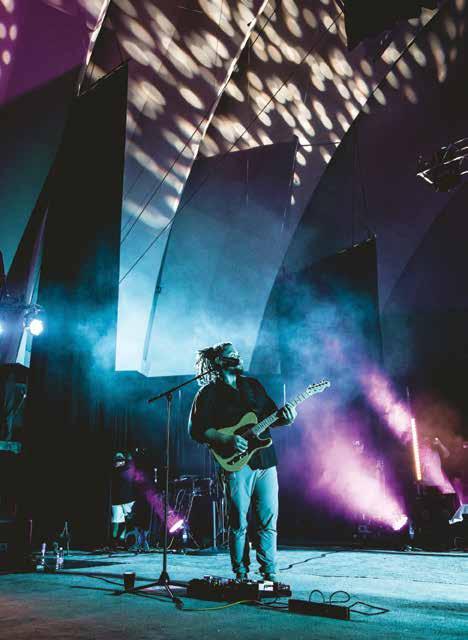 � Shown above, Zion Thompson on guitar. Opposite, lead singer Caleb Keolanui.
� Shown above, Zion Thompson on guitar. Opposite, lead singer Caleb Keolanui.
A musician scales watery depths to form a creative kinship with the ocean’s majestic mammals.
TEXT BY BRITTANY LYTE IMAGES BY FLIP NICKLINOn a small boat off the coast of Maui, David Rothenberg watches a whale surface and then abruptly disappear. The animal’s dive into the depths of the island’s quiet winter waters is Rothenberg’s cue that the start of a performance is near.
A philosopher and jazz musician, Rothenberg
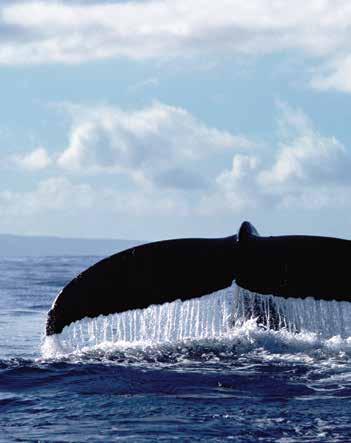
hurriedly unpacks his clarinet. He shapes his lips to the mouthpiece and blasts into the instrument a steady stream of air. An underwater speaker delivers the resulting warm, velvety sound 50 feet underwater, where a whale, presumably the one Rothenberg spied off the starboard bow, can be heard letting out a lowpitched wail.
For a while, Rothenberg lowers his clarinet and listens. The whale’s song, picked up by an underwater hydrophone, plays in his headphones at an adjusted speed to account for the movement of sound in water. A data visualization of the whale’s bluesy bellows will later reveal the sound as a series of long, repeated phrases, no different than any modern pop song.
Rothenberg waits for a pause in the whale’s moans before returning
Man and mammals create aquatic anthems that tap into the universality of music.
� Humpback whale tail, Hawaii. FLIP NICKLIN/ MINDEN PICTURES.
NMFS PERMIT #13846.

the clarinet reed to his bottom lip and performing a high-pitched riff. The whale then makes a noise that seems to mimic that of the clarinet. For a time, the man and the whale appear to engage in a playful call and response. Then, as if the whale has lost interest, the musical charade falls apart.
Birds sing to impress mates and mark territory. Insects have courting songs and little looped melodies to ward off predators. Yet since scientists realized the musicality of humpback whales 50 years ago, the purpose of whale song remains unknown. Vocalized by males during breeding season, for which they travel great distances, whale song is a complex sequence of moody melodies shared across an entire species population. Each breeding season, the music changes. We do not know how these songs are developed, why they shift with the seasons, and what, if anything, they are saying. What we do know is that whales thousands of miles apart will sing the same song. Over time, the song changes, indicating that these animals have the
capacity to alter their haunting hymns based on the sounds of other humpback whale populations that reverberate throughout the ocean’s waters. Whether a man with a clarinet and an underwater speaker can influence these aquatic anthems is not yet known.
A probe into the universality of music, Rothenberg’s improvised interspecies duets aim to augment what little is known about why a whale will vocalize for up to 23 hours on end without stopping. What can be learned about music based off of how cetaceans respond to sound underwater? Is it possible to understand through these animals why some music moves us to tears and other melodies make us want to dance?
Far from shipping lanes and offshore oil rigs, Maui’s relatively noiseless waters are a prime stage to hear live humpback whale performances. On a half-dozen occasions over the last 10 years, Rothenberg has traveled to Maui and ventured out to sea, clarinet in hand, to explore what can be gleaned from a musical approach to exploratory learning.
� Humpback whale female with calf, Hawaii. FLIP NICKLIN/MINDEN PICTURES. NMFS PERMIT #987.
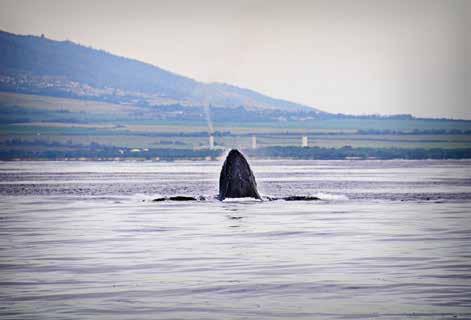
“It’s very humbling to join into this vast arrangement of song happening underwater,” Rothenberg says. “Sometimes you really can tell that the whales are changing their song in response to the clarinet. Sometimes it’s like they’re ignoring you. It’s hard to say what it all means, but you do feel like you are tapping into the mystery by communicating with this other species and creating something together with a whale that no single species can create alone.”
Rothenberg, who is 55 years old and resides in upstate New York, has taken his musical experiments around the globe, engaging orcas in Canada and belugas in Russia. With the album Whale Music , he delivers to listeners a musical account of these explorations via deep-sea symphonies. Some tracks are unedited live interactions between the clarinetist and the whales. Others are studio-produced songs inspired by the whales’ ethereal musical aesthetic. Played on clarinet, violin, or percussion, these arrangements demonstrate how humans can learn from the giants of the deep.
What, then, might whales have learned from Rothenberg’s lilting notes on the clarinet? It’s hard to say. Today, scientists consider whale song an element of breeding; they just aren’t sure whether males use it to attract females or to ward off competing males. But Rothenberg, who believes whales sing to emote, likens his whale encounters to sharing a stage with another instrumentalist who doesn’t speak the same tongue. There’s a lot that two musicians can communicate and impress upon one another without ever uttering a word.
“The shared song of the humpback whale is one indication that animals do have culture,” Rothenberg says. “People start to cry when they hear it. Is it just that people are amazed that whales are singing that moves them to tears? No, it’s the whole way the whales are intoning these sounds with form and shape in the same way that music created by humans touches people. It’s a shocking and beautiful thing coming from deep in the sea.”
� A whale breaches against the backdrop of the West Maui mountains. Image by John Hook.
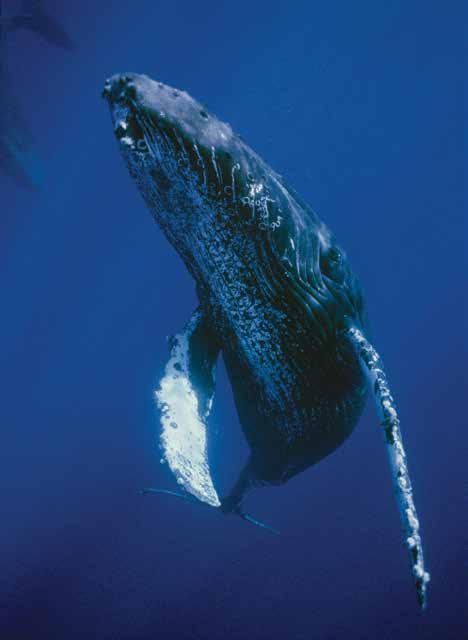 � Humpback whale singer, Maui, Hawaii. FLIP NICKLIN/ MINDEN PICTURES. NMFS PERMIT #987
� Humpback whale singer, Maui, Hawaii. FLIP NICKLIN/ MINDEN PICTURES. NMFS PERMIT #987
 � Freediving in the waters off
� Freediving in the waters off
“Your body can only physically keep up so much. You need to change things up if you want to progress.”—Yancy
Medeiros

An afternoon on the West Side with the UFC welterweight and mixed martial artist.
Yancy Medeiros has reached a new level of calm. Stretching in the yard of his parents’ house, the mixed martial artist is relaxed as he recounts the past few years, the conversation animated by his boyish grin and quick laugh. At 30 years old, he has seen 19 professional fights in four different weight classes. But

despite winning his last two Ultimate Fighting Championship matches, he’s at an age where he knows that balance and stability in life is more important than any single win.
Once just a kid trying to make it on the rough West Side of Oʻahu, he now travels the world fighting in the UFC. With this fame and attention come temptations and demands of his time that Medeiros knows can distract him from his focus. “I am very appreciative, but at times it can be overwhelming,” he says. “Hence, I find myself back at home, back where I started.”
Home, for Medeiros, is the wooden house he grew up in with his parents and two sisters in Waiʻanae. It sits a block from a quiet stretch of beach and has a large lānai overlooking a yard filled with mango and orange trees. “This is my safe haven. This is where I know I’ll be alright in life,” he says. “I try to get out and represent Hawai‘i as best I can, but at the same time, I don’t want to miss out on the quality time I can have with my immediate family. I don’t want to take time for granted.”
Three years ago, when Medeiros was fresh off his first UFC win, he was commuting frequently between Hawai‘i and training camps in California. These days, he’s based full time back on Oʻahu. While he occasionally cross-trains in
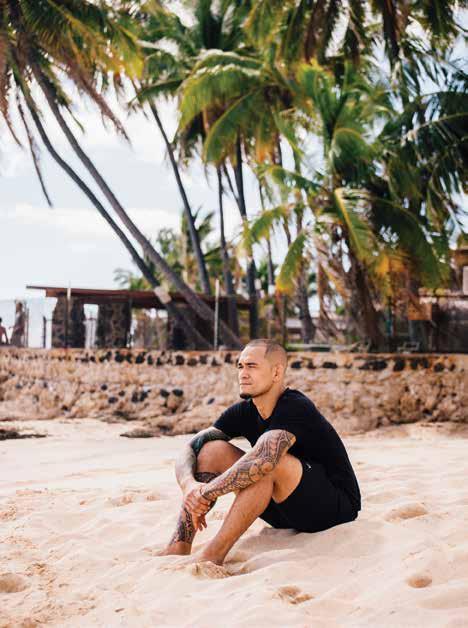
� Regular homecomings to O‘ahu’s west side, where Yancy Medeiros grew up, help him achieve balance in the whirlwind world of mixed martial arts.

Waiʻanae, Medeiros usually heads to Kalihi or Kakaʻako to meet up with his teammates.
For professional MMA fighters, there is no such thing as being in season or out of season—instead, it is a daily way of life. While each week’s schedule is different, he remains committed to putting in his 40 hours a week of training, as if he had a 9-to-5 job. Practices change daily and are a combination of wrestling, jiu jitsu, strength and conditioning, and muy thai. Recently, Medeiros has added yoga to the mix. After waking up at 6:30 a.m., he usually heads to Bikram yoga in Kapolei for a 9 a.m. class.
“Now that I’m getting older, I don’t need the wheel to go harder, I need to turn a different wheel—I have to be smarter,” Medeiros says. “Your body can only physically keep up so much. So, how do you keep your optimal performance with what is going on chronologically? You need to change things up if you want to progress.”
Medeiros, and his contemporaries Max Holloway and Kailin Curran, all of whom are from the West Side, are part of a new generation that has been following in island-favorite BJ Penn’s footsteps to shine
a spotlight on Hawai‘i in the MMA world. In Waiʻanae, Medeiros says, he was always surrounded by positive people who shared their love of Hawaiian culture. This aloha spirit, in turn, is what he tries to bring to the sport.
One way Medeiros gives back to his community is by encouraging youth to do the same. West Oʻahu MMA, the gym where he started his career, is open to any kids who want to come in and train, and Medeiros will often pop by, put on some gloves, and do drills with those who’ve shown up.
“I like keeping kids off the street,” Medeiros says, priding himself on never being in a street fight growing up, instead having channeled that energy into martial arts. “When I come in there, their eyes light up, and I say, ‘Hey, this is where I started.’ For me, when I was that age, seeing someone who made it was motivating, so hopefully I can motivate them by putting in my work. Fighting isn’t everything. It’s more than just getting to the top. It’s to be stable and be a positive role model.”
� At this stage in his fighting career, Medeiros has begun to incorporate yoga into his daily regimen. Paschimottanasana, or seated forward bend, improves circulation and increases concentration.



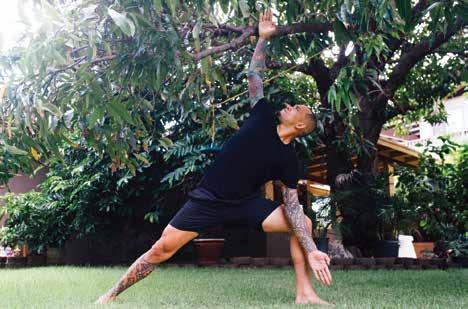
Entering a new chapter of his physicality, Medeiros turned to Bikram yoga three years ago. “I want to be loose, I want to be functional,” he says. “I don’t have to be Superman, I’d rather be Spider-Man.”
These two poses help the MMA fighter start the day.
(POSH-ee-moh-tan-AHS-anna)
Seated Forward Bend, or Intense Dorsal Stretch
ONE Sit up with legs stretched straight in front of you on the floor. Keep spine erect and toes flexed. Breathe in and slowly raise both arms straight above head and stretch upward. Deeply inhale.
TWO Exhale slowly and bend forward from the hip with chin moving toward the toes. Continue to keep spine erect.
THREE Reach to place hands on legs wherever they naturally rest. If able, hold your toes and pull yourself forward to them.
FOUR Hold pose for 10 seconds.
FIVE Repeat for three to four rounds.
(tree-koh-NAH-suh-nuh)
Triangle Pose
ONE Stand with legs a length apart, heels aligned, and right foot turned 90 degrees outward. Keep thighs firm, and turn right thigh outward with right knee cap in line with center of right ankle.
TWO Exhale while extending torso to the right over right leg, bending at the hip. Strengthen left leg and press outer heel into the floor. Rotate torso left and let the left hip move slightly forward.
THREE Rest right hand on shin, ankle, or the floor outside right foot. Stretch left arm up to the ceiling.
FOUR Hold pose for 30 seconds.
FIVE Change leg and feet positions and repeat to the left.
� Trikanasana, or the triangle pose, alleviates anxiety and stimulates the nervous system.

�
Beneath the palms in Wai‘anae, O‘ahu. Medeiros steadies the demands of the UFC on the restful shores of his youth.Dance has helped Emilia Villaver Daquioag connect with family, friends, and the community in ways unavailable to her through spoken language.
TEXT BY CHELSEA TSUCHIDA IMAGES BY JOHN HOOKIn his audition tape for the nationally televised competition So You Think You Can Dance , Hawai‘i-born Mark Villaver credits his mom with introducing him to dance. A top-10 contestant on the 2017 season of the show, Villaver can be seen grooving with his mom—who beams with the excitement of a young girl—to Usher’s “She Came to Give It to You” in a 2014 YouTube clip that has garnered more than 1.6 million views. What may be more surprising than Villaver’s ascent, however, is the fact that his mom, Emilia Villaver Daquioag, is deaf.
Emilia does not know if she was born deaf, or if it manifested early in her life. The 49-year-old was born in Cebu, a province in the Central Visayas region of the Philippines, and her parents could not afford the advanced medical care that could identify her hearing impairment. Her father earned money from chicken fights and the occasional game of dice, pocketing five Philippine pesos a game (the equivalent of a dime today). It wasn’t until Emelia and her family, including her seven siblings, moved to Hawai'i when she was 2 years old that she and her twin sister, Amalia (also a dancer) were identified as deaf. “I noticed I was different when I entered elementary school,” Emilia says, signing swiftly. “Everybody was speaking, and I was completely lost. I had no idea what was going on.”
To communicate, Emilia relied on facial expressions and hand gestures—a creative combination of Filipino and American motions, and others that she and her sister made up. Emelia did not learn American Sign Language until she was 25 years old, and even now, her family is not fluent in the language, save for Amalia, who taught Emilia after learning it from deaf colleagues at her first job. With limited means of communication, and feeling isolated from her peers at school, Emilia found solace and acceptance through dance. She recalls observing street dancers practicing at Kanoa Park in Kalihi. “I
would just watch and kind of drool … watching all the dancers, wanting to be like them,” Emilia says. The two sisters studied and mimicked their movements, and then interpreted them. Despite a short stint of classical jazz classes, Emilia most enjoyed the versatility and creative freedom of urban styles like hip-hop, popping, and locking.
Vibrations are what connect Emilia with the rhythm, beat, and emotion of a song. “I really focus on the movement of the music, and I try to match that,” she says. “I’m not as interested in the story of the song. I just like the beat. What feels good to me, that’s pretty much what I follow.” Naturally, she was drawn to genres with distinct bass lines, like rap, hip-hop, and pop. Lyrics, on the other hand, are completely irrelevant. “If someone is cussing in a song, I have no idea,” she says. “I’ll be dancing, I’ll be grooving to it, and people will smack me and say, ‘Hey, that’s a really dirty song!’ I’m like, ‘I don’t care. I just like it!’”
In high school, Emilia had aspirations to become a professional dancer, but these were put on hold after she became pregnant with Mark’s older brother. Instead, her dreams have been fulfilled by the success of Mark, a professional dancer who has performed with Ariana Grande, Demi Lovato, and Taylor Swift, and who is a member of L.A.-based dance group Quest Crew. She also is happy that she can pass along her experience to students at the Hawai‘i School for the Deaf and Blind, where she serves as a house parent for the deaf students who dorm during the school year. In addition to supervising the students, she teaches them how to dance as an afterschool activity.
Dance is a physical manifestation of emotion, a universal language, and expression through movement. For Emilia, who considers herself culturally deaf because of how she relates to the hearing-labeled world, dance has given her confidence and the support of a community. It has filled the silence.
EYES Emilia uses visual cues in place of auditory ones. She observes the emotion and body language of others, and then uses that information to react.
BODY Emilia’s body moves to the vibrations of a song. Her favorites? “WTF” (“Where They From” by Missy Elliott featuring Pharrell Williams), and anything by Chris Brown or Justin Bieber.
MIND Emilia tries her best to understand how people communicate differently. She recommends learning a new language, even a bit of sign language to communicate with people who are deaf.
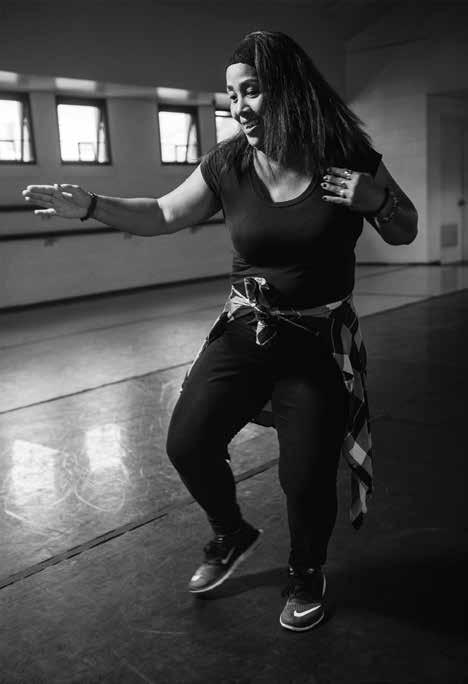
Underwater breathing extends to mental relaxation, teaching us the true meaning of calm during freediving.
TEXT BY JEN MURPHY IMAGES BY JOHN HOOKAs I slowly pull myself hand over hand along a weighted line into the depths of the sea, I fight to ignore the pressure building in my ears, and the spasm rising in my diaphragm that is signaling my body to breathe. Rays of sunlight spike through the ocean, spotlighting my final destination: a sunken ship 97 feet below. I try to let the soft serenades of
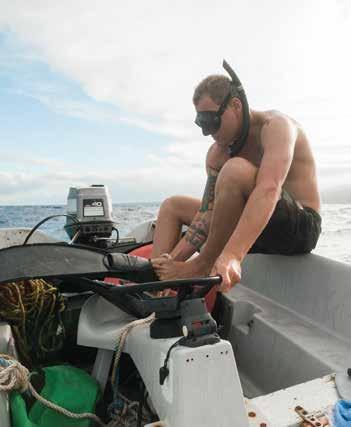
humpback whales lull me into a Zen-like trance as I repeat the mantra, “Just relax,” in my head.
But all I can think about is breathing. When I look upward, the sight of the ocean’s surface triggers a panic. I kick my fins urgently until I pop above water. My freediving instructor, Benjamin Zyons, leads me through six deep exhalations, known as purge breaths, to help clear the carbon dioxide that has built up in my body. I give him the signal that I’m OK, aware that 90 percent of freediving blackouts occur after surfacing. Then I remove my mask and sheepishly acknowledge my freak-out.
Freediving, despite popular belief, isn’t about holding your breath, as much as it is about learning to stay calm in discomfort. Zyons, the founder and lead instructor of Mauibased Freedive Hawaii, describes the sport as “underwater meditation.” He moved from Rhode Island to Hawai‘i in 2004 for the surfing, and then discovered freediving. “Growing up, I’d dive near the shore for mussels and lobster, but I had no idea that freediving was its own sport and that the body could sustain depths of 200-plus feet,” he says. He spent eight years honing his skills and, in 2014, launched Freedive Hawaii. I grew up in the ocean, so I had assumed I’d be a natural at freediving. But I quickly realize I need to


retrain my brain if I want to safely reach depths of 100-plus feet. In order to hold my breath underwater, I first must relearn to breathe on land. A few weeks after my first dive attempt, I sign up for a landbased workshop with Zyons at Lumeria, a wellness retreat in Upcountry Maui. Here, Zyons, a certified yoga instructor, leads me and four others in the class through a series of breathing exercises. Anyone can learn to freedive, Zyons says to me, assuring “all humans have a mammalian diving reflex.” When this physiological reaction kicks in, the heart slows, peripheral blood vessels constrict, and the spleen compresses to dope the body with red blood cells. These reactions, Zyons explains, help to reduce the consumption of oxygen, while continuing to provide sufficient quantities to vital organs.
We lie on the ground in the shade of pine trees, our hands on our bellies and eyes closed, as Zyons instructs us to let the stomach expand. We inhale deeply, stretching the chest’s intercostal muscles to maximize the space for the lungs, then sip in still a bit more air. Two muscle groups are involved in breathing: the diaphragm,
which is right below the lungs, and the intercostal muscles, which help the chest and rib cage contract and expand. If we are belly breathing correctly, our bellies should be expanding and deflating like a balloon. Chest breathing, Zyons explains, increases the feeling of anxiety.
Next, Zyons has us partner up (rule no. 1: never dive alone) before moving to Lumeria’s pool to practice static apnea exercises, basically the dead man’s float. My partner effortlessly pulls off a twominute hold on her first attempt. I follow, and barely keep my face in the water for 30 seconds. Despite the buoyancy of my wetsuit, Zyons can see my body is tensed: My elbows are locked, neck strained. “Relax,” he urges.
I try again, this time closing my eyes and imagining the beach. I feel a jolt of pressure in my diaphragm, but when my partner taps my shoulder to see if I’m OK, I signal with my finger that I can stay down. “You need to decipher between what you think is the urge to breathe versus what is the real need to breathe,” Zyons says. This time, I last a minute and a half, and when I surface, I’m not gasping for air.
� Described as “underwater meditation,” freediving hones the mind-body connection of those who do it. Shown above, Benjamin Zyons, freediver and founder of Freedive Hawaii, ascends from the deep blue waters off Maui.
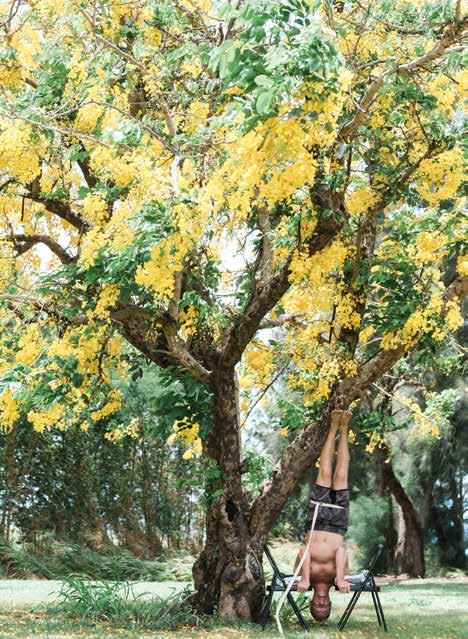
� Breathing principles sharpened during freedive training can help the body to relax even on land.
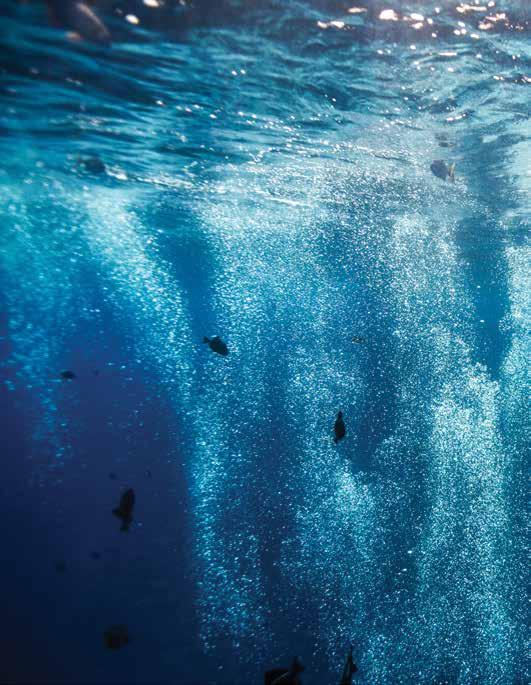

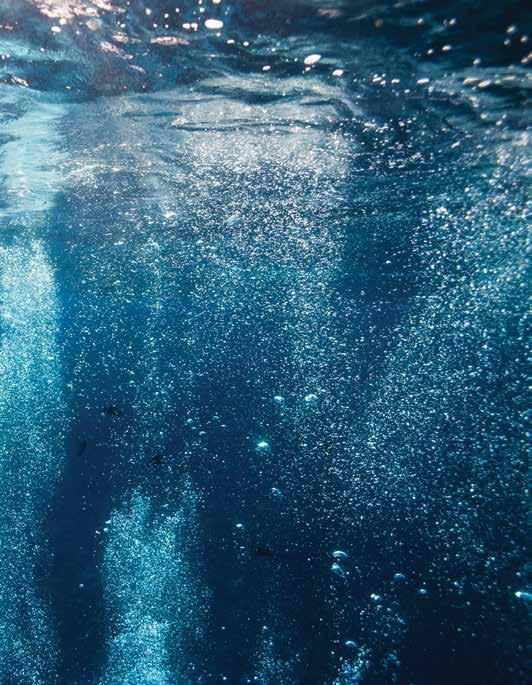

After the course, I embrace a daily breathing practice. A few weeks later, I’m ready to reattempt my ocean dive, this time to the Carthaginian , a sunken ship that sits about a half-mile offshore from Puamana Beach Park. During the journey there on my stand-up paddleboard, I calm my breath and mind. This time, Zyons dives down alongside me. I equalize my ears and feel my heartbeat slow. After a few seconds, my body begins to ignore the urge to breathe, my mind quiets, and my muscles relax. Then, for the first time, I feel complete serenity under the sea.
Are you a belly breather or chest breather? This breathing exercise hones proper diaphragmatic breathing to help retain one’s breathe longer underwater, but the same principles can be applied to relaxing your breathing on land.
ONE Lie on your back with a rolled towel under your head. Place a lightweight object on your stomach.
TWO Close your eyes and imagine a string attached to your naval being pulled straight up and down as you inhale and exhale. Feel the object rise and fall with each breath.
THREE On your inhale, fill your stomach with air, so you have a potbelly. Pause at the top of the inhale. Slowly exhale, drawing the stomach inward as the air escapes from the lungs comfortably, like air releasing from a pinched balloon. Pause at the bottom of the exhale.
FOUR Repeat until a state of complete relaxation is achieved.

Experience the wonder of O‘ahu’s underwater world.
We offer scuba charters and ride along snorkeling along O‘ahu’s beautiful west coast, classes of all levels from beginner to divemaster, as well as specialty classes such as Nitrox and Deep Diver.
TWICE DAILY SCUBA DIVE CHARTERS FROM KO OLINA MARINA PADI CERTIFICATION FOR ALL LEVELS
BUBBLEMAKERTM PROGRAMS FOR AGES 8–10





Jane Murao turns challenges into opportunity with Haul2hi, a company that provides consumers with functional, welldesigned furniture at a fraction of the cost.
About a decade ago, when my husband and I were in college, we moved into our very first place. It was a tiny studio in central Honolulu, and we had the hardest time finding furniture on O‘ahu that would fit into the space at the right price point. Years prior, I had visited an Ikea store on the mainland, and had fallen in love with its space-saving storage options, affordable prices, and great design. But there was one problem: Ikea didn’t deliver to Hawai‘i. I joked
with my husband that we should fly to an Ikea store and bring a bunch of stuff back home. He thought I was crazy, so we made do with what we could find on the island.
As time went on, I still felt that the furniture selection on O‘ahu was limited. So in 2013, with two children in tow, my husband and I created our company, Haul2hi, in a tiny storage unit. Our mission was to provide the people of Hawai‘i access to functional and affordable Ikea home furnishings at an unbeatable price.
We have since outgrown our tiny storage unit. From our street-front location at 1148 Bethel Street in the heart of downtown Honolulu, we are able to ship just about anything Ikea carries. We also offer free commercial and residential design services, helping with room layout and product selection.
Every week, orders arrive for our customers, who face similar challenges as we did. They have small bedrooms and living rooms with little


to no storage, or they are looking to modernize and maximize their tiny kitchens. We are excited to see that Ikea has been able to address these issues with numerous innovative furniture items, such as beds with built-in drawers and headboards with storage, sofa sleepers with lift-up storage compartments, and customizable entertainment systems with floor-to-ceiling storage. Not to mention that Ikea kitchens are known for their endless interior storage options and custom designs—at a fraction of the cost.
To see it come full circle has been exciting and rewarding. I’ve been able to help better the lives of not only my family, but also of those in my community by providing access to affordable, functional, and welldesigned furniture.
� For more information, visit haul2hi.com

 � Kaua‘i’s north shore. Image by IJfke Ridgley.
� Kaua‘i’s north shore. Image by IJfke Ridgley.
“Proud are you, of the rain that pelts the skin. The mind goes forth, to the edge of the sea.”—Alfred Alohikea, lyrics translated from “Hanalei Bay”

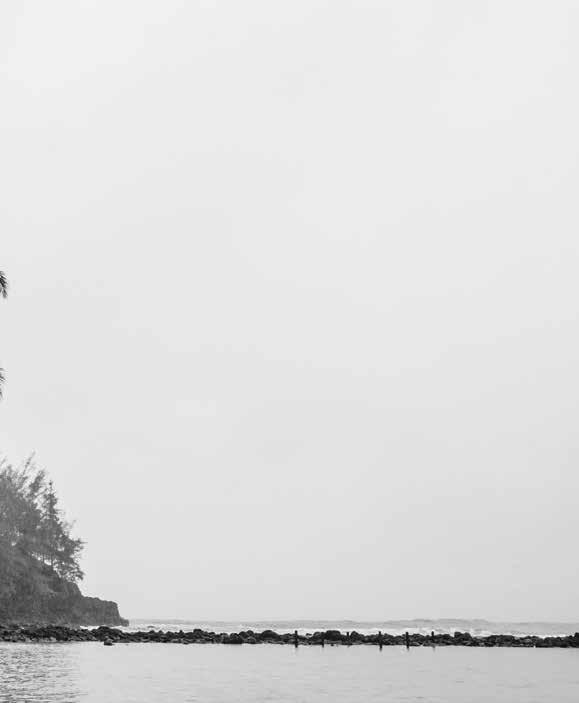
What to do on a grey day on the north shore of Kauaʻi.
TEXT ANDIMAGES
BY IJFKE RIDGLEY
Driving along Kuhio Highway on the north shore of Kauaʻi can seem like an endless journey with no destination. In stark contrast to the wide expanse of flat, red dirt on the west side of the island and the sizable cities of Līhuʻe and Kapa‘a on the east, the north shore is dominated by wet, breathing jungle. The road curves through miles of dense greenery from Kīlauea to Hāʻena. Flanked by dramatic mountains, one catches glimpses of the coastline before reaching the road’s end at the base of the towering Nā Pali coastline. Even Princeville, with its combination of resorts and a strip mall, passes in the blink of an eye. But if you are looking for action, you are missing the point: precisely, all that nature.
The daily rainfall, especially on the north shore, is what keeps everything lush on the
� When traveling to Kaua‘i, one of the wettest islands in the archipelago, visitors should embrace (and plan for) its routine rainfall.

� Stand-up paddling, among other water-based activities, are woven into the everyday lifestyle of Kaua‘i’s north shore denizens.
Garden Isle. In the winter, high surf pounds the coastline and morning showers can turn into weeks-long deluges. Flash floods, originating in the mountains, rage through the numerous streams and valleys, and locals watch the water level to make sure they won’t get stranded—when the Hanalei River reaches eight feet, the bridge between Hanalei and Princeville closes. While summer brings calmer seas and drier weather, sunshine is never guaranteed on the island that is home to the wettest place on earth, Mount Wai‘aleʻale. On Kauaʻi, drizzling and downpours are a yearround phenomenon. So when you’re here, don’t be afraid to get a little wet. Here are some ideas to beat the rainy-day blues:
Follow Kīlauea Road through Kīlauea town to its end at Kīlauea Point National Wildlife Refuge. On the way, stop for some roadside provisions at Eden’s Garden Stand, which holds fresh, organic produce like mandarin oranges or lilikoʻi—simply leave money in the box in exchange. Hike to the lighthouse on the tip of the peninsula to view the north shore scenery and perhaps
even spot some humpback whales during the winter months. The refuge closes at 4 p.m. (and is also closed Sundays and Mondays), so before sunset, head down the road to the St. Regis Hotel in Princeville. Have a drink on the lānai overlooking Hanalei Bay and iconic Mount Makana, also known as “Bali Hai” from the movie South Pacific. This area is also the starting pinnacle of the dramatic Nā Pali coastline.
The north shore of Kauaʻi is at the top of every outdoor fanatic’s must-see list, as it serves as the jumping off point of the legendary Nā Pali coastline. Miles of velvety green peaks and valleys, folded as tightly as an accordion, wrap around the northwestern corner of the island and plunge directly into the ocean, leaving the famous Kālālau Valley accessible only by hike or boat. Where the road ends at Keʻe Beach, just after Hāʻena, the Kālālau Trail starts. The 22-mileroundtrip hike is arduous and takes planning—you must factor in camping, supplies, permits, dangerous conditions, and weather—and is not for the amateur hiker.
However, if the weather holds, even beginners can try the first section, the
� The rocky peninsula of K ī lauea Point is the site of a recently restored, century-old lighthouse and a wildlife sanctuary.


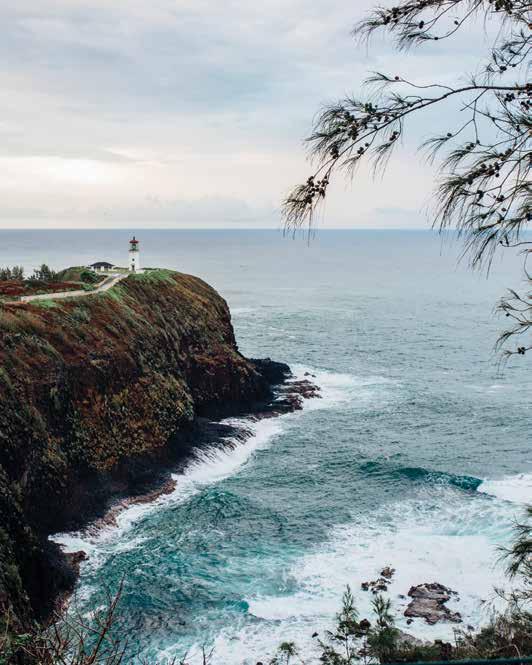
four-mile-roundtrip hike to Hanakāpīʻai Beach, which can be completed in a day. Start off with an early meal at Hanalei Bread Company, with items like freshbaked pastries and warm breakfast biscuits. Pack a few of its burritos for the perfect mid-trail snack.
A nice hike for a drizzly day is the ‘Ōkolehao Trail, which begins just after the Hanalei bridge. The twomile trek passes high above Hanalei and offers views of the bay. Beware, the trek will be muddy and steep. Those who prefer a casual stroll should instead head to the Limahuli Botanical Garden. Tucked in next to Mount Makana, the garden focuses on plants native to the islands or significant to Hawaiians. Entrance costs $20, and the garden is closed on Sundays and Mondays.
When most of the north shore is encountering huge swells and rip currents, there is one beach that remains decidedly calm: ‘Anini Beach, located halfway between Kīlauea and Princeville. Here, a long stretch of sand in a residential neighborhood is flanked by a fringe reef that keeps out the waves. You are already wet, so why not go snorkeling? Even

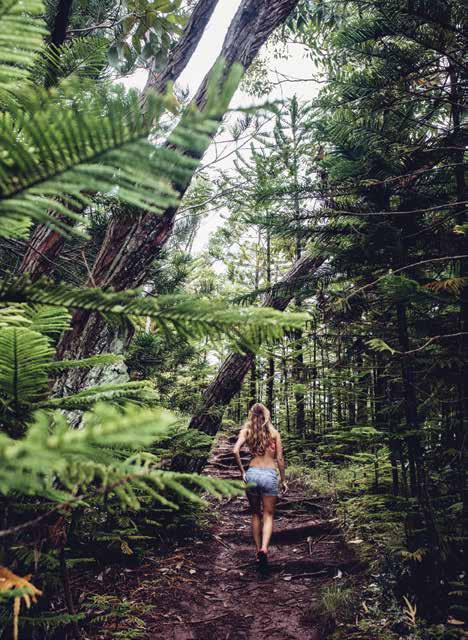 � The outdoors can still be explored in all its damp and dewy beauty.
� The outdoors can still be explored in all its damp and dewy beauty.
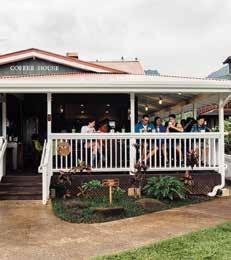
during a drizzle, the water is clear and calm, and there is plenty to see. Another activity that is great for a rainy day is a tour of the placid Hanalei River via standup paddleboard or kayak. Rent a vessel in Hanalei— you can’t miss the signs advertising this along the road—and head upstream under the Hanalei Bridge and along lush banksides of taro fields and coconut trees. You may also spot the occasional nēnē, Hawaiʻi’s endemic goose. It’s a great way to see the part of Hanalei not visible from the road, and to get a core workout while you’re at it. For lunch, pick up a poke bowl or maki roll from Sushi Girl in Hāʻena, which serves healthy takeout meals made from fresh fish and local ingredients. Next door to this adorable stall is the equally picturesque Wainiha General Store, the last stop for shopping before the end of the road.

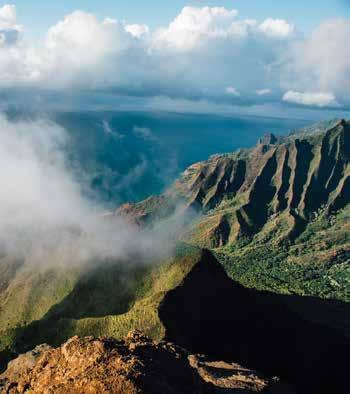




When the weather isn’t cooperating, there is nothing a cocktail (or three) can’t fix. Bar Acuda is the closest thing to a swanky cocktail bar in Hanalei, with its tasty tapa menu and extensive wine list. For a more laidback island vibe, Tahiti Nui in Hanalei hosts good crowds and live music among décor reminiscent of a thatched tiki hut. Caught in Princeville? Nestled in a strip mall is a gem of a tiki bar, Tiki Iniki, complete with the requisite kitschy interiors and rockabilly bartenders. The lively establishment also has full menus served from daybreak to midnight featuring ingredients sourced from local farmers—and of course, it also offers all your favorite tropical drinks. Be sure to try the Iniki, the signature cocktail named after the 1992 hurricane that decimated Kauaʻi, which is served in a tiki tumbler and topped with a broken umbrella.
� In Hanalei, surf lodges, tiki bars, and organic grocers coexist. When it rains, consider it prime time to shack up in one or all of them.


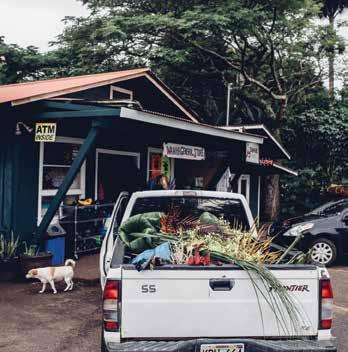


The winners and finalists of the inaugural PhotoCon Hawai‘i.
PhotoCon Hawai‘i, the worldclass photography convention that not only fulfills the needs of the professional elite, but acts as a platform for photographers of all types and skill levels to connect, interact, and learn together, took place in October 2017.
Photographer Ric Noyle created this 5-day event here in Honolulu after attending dozens of PhotoCons all over the United States, meeting like-minded creatives and being introduced to new tools of the trade. “Back in the day, I used to see other photographers at photo labs, and we’d communicate that way,” Noyle says. “But today, in the digital world, we are all independent. There isn’t a lot of connectivity amongst ourselves.” World-class speakers and talent from the Aloha State came together to share, teach, and create with more than 25 workshops.
Throughout, photographers of all levels, from hobbyist to professionals, submitted images to its Essence of Hawaiʻi Photo Contest, a statewide search for the images that best exemplify the people, scenery, and culture of the islands. To reflect the current landscape of Hawai‘i, only images shot between 2016 to 2017 were eligible. The winners and finalists are printed here and on the following pages.
1 ST PLACE
Lance Agena from Honolulu; location, Kapahulu Groin
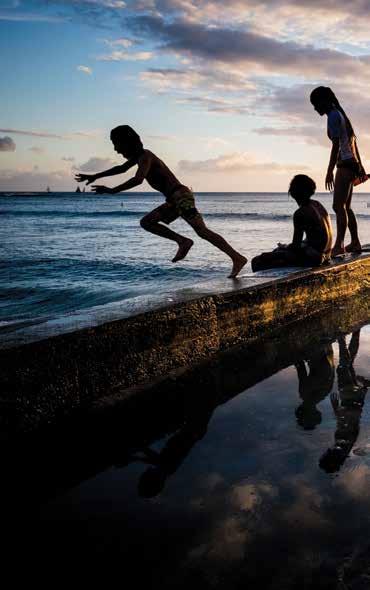


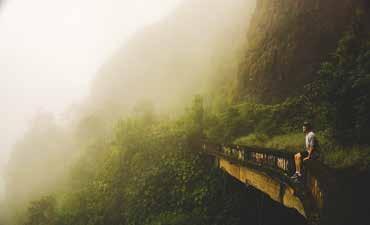
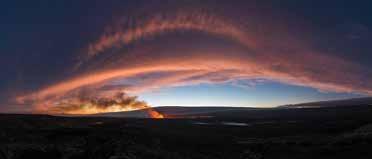 3 RD PLACE Raiatea Arcuri from Mountain View; location, Hawai‘i Volcanoes National Park
3 RD PLACE Raiatea Arcuri from Mountain View; location, Hawai‘i Volcanoes National Park
 DJI AND DRONE SERVICES HAWAII AERIAL AWARD
DJI AND DRONE SERVICES HAWAII AERIAL AWARD





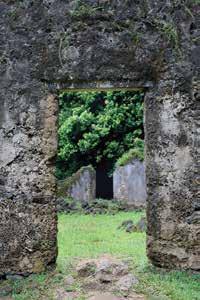 Lyle Roe from ‘Ewa Beach; location, O‘ahu
Sky Bruno from K ā ne‘ohe; location, Hawai‘i Island
Lyle Roe from ‘Ewa Beach; location, O‘ahu
Sky Bruno from K ā ne‘ohe; location, Hawai‘i Island

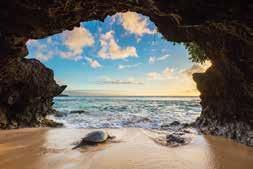
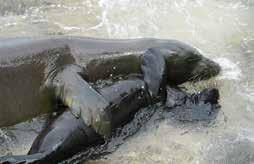
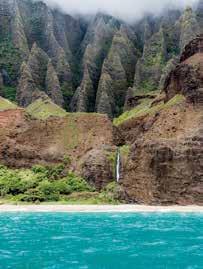

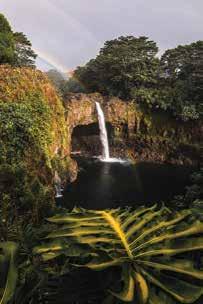 Davin Phelps from Lahaina; location, Kaua‘i
Joshua Esteban from Hilo; location, Hawai‘i Island
Davin Phelps from Lahaina; location, Kaua‘i
Joshua Esteban from Hilo; location, Hawai‘i Island


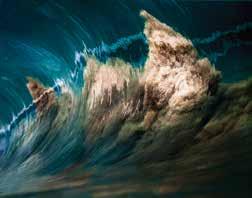


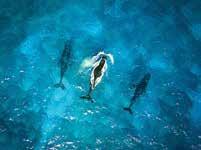
 Jason O’Rourke from ‘Ewa Beach; location, O‘ahu
Thomason Takata from Honolulu; location, off Hawaiian waters
Nolan Omura from Honolulu; location, O‘ahu
Jason O’Rourke from ‘Ewa Beach; location, O‘ahu
Thomason Takata from Honolulu; location, off Hawaiian waters
Nolan Omura from Honolulu; location, O‘ahu
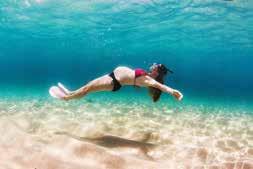
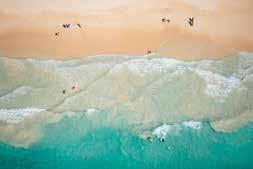

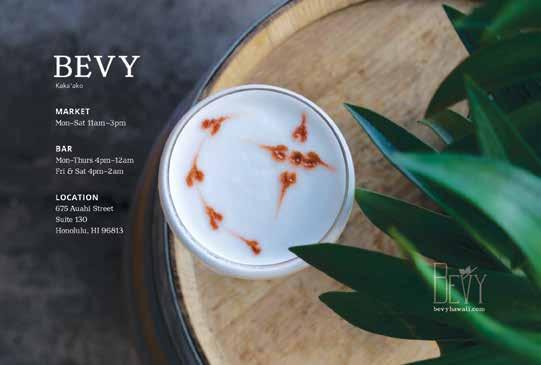









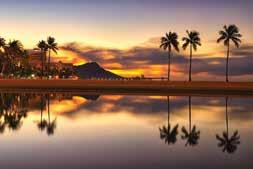

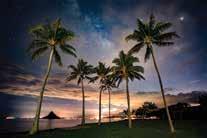


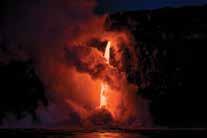 Peter Tang from Honolulu; location, Kualoa Beach Park
Christopher Lum from Honolulu; location, Haleakal ā National Park, Maui
Raiatea Arcuri from Mountain View; location, Hawai‘i Island
Peter Tang from Honolulu; location, Kualoa Beach Park
Christopher Lum from Honolulu; location, Haleakal ā National Park, Maui
Raiatea Arcuri from Mountain View; location, Hawai‘i Island
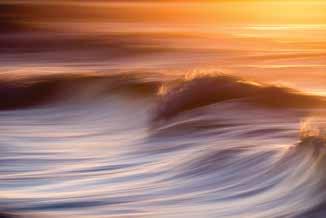

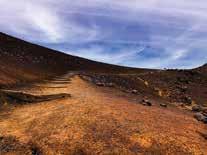
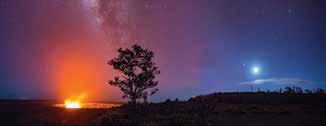

A delightful, island lifestyle boutique featuring hip local artisans and a lovely selection of clothing, accessories and gifts.
� For more information, find Betty x Joe on Instagram @bettyxjoe. Located at 41 Kihapai St. in Kailua, Hawai‘i.
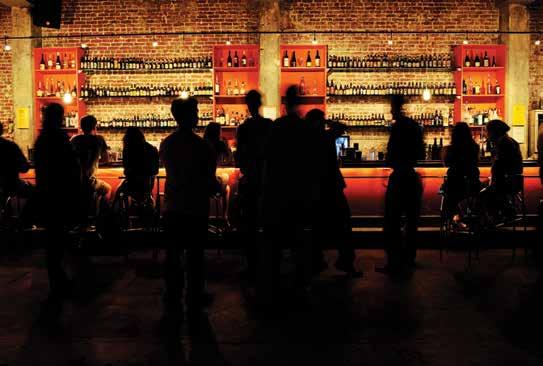
Honolulu’s Happiest Happy Hour
Monday–Friday, 4–10pm
We offer over 240 different beers from around the world, premium cocktails and spirits and hand-crafted pizza.
Conversation during conflict is the topic of The World Reflected at the Honolulu Museum of Art at Spalding House, the loveliest little museum in the Pacific.
TEXT BY SONNY GANADEN IMAGES COURTESY OF HONOLULU MUSEUM OF ARTA steep kilometer up Tantalus Drive, on the western flank of Mānoa Valley, the Honolulu Museum of Art Spalding House campus boasts a clear view of almost the entirety of Honolulu, from the famous profile of Lē‘ahi in the east to the construction cranes and skyscrapers of downtown. The grounds of the

museum, an immaculately maintained former estate, are at enough distance from the road to quiet the mopeds ascending switchbacks, and the feral roosters crowing at all hours of the day.
The serene mountainside museum seems an unlikely place for a rigorous discussion of American domestic political power in contemporary art. But its current exhibit, The World Reflected, brings the controversies of the nightly news to Honolulu, a place with its own political battles. The artworks presented in its grand series of rooms were mostly created by living artists, and were collected over the last several decades by the Honolulu Museum of Art and the former Contemporary Museum of Honolulu, which was incorporated in 2010.
The show is organized in loose, unlabeled
� Lesley Dill (American, born 1950) Voices in My Head , 1997 Charcoal and thread on gelatin silver print. Gift of The Contemporary Museum, Honolulu, 2011, and purchased with funds derived from gifts of Donald Angus, Helen Eskridge Rodman, Kenneth Kingrey, and the Honolulu Advertiser Collection at Persis Corporation, by exchange (TCM.1997.49)

themes. Past the first room of portraits, an annex displays recently purchased work by Cheyenne and Arapaho artist Edgar Heap of Birds from his series Dead Indian Stories. The four monoprints of maxims on red-dyed rag paper, two of which read “HAPPY TO DONATE WHAT YOU TOOK” and “WILL GET ILL FROM STATIC BELIEFS,” face a lithograph of a deconstructed American flag by Vito Acconci that hangs on the opposite wall. In the next room, alongside a large photograph of a fist by John Coplans and a portrait of Willie Horton by Robert Arneson, is a small work with a big name: Freedom, a Fable: A Curious Interpretation of the Wit of a Negress in Troubled Times, by influential American artist Kara Walker. Having a Kara Walker piece is a big deal. Her installation
A Subtlety, a massive sphinx-like monument with the face and curves of an AfricanAmerican woman that was coated in refined
sugar and housed at the defunct Domino Sugar Factory in Williamsburg, New York City, was, arguably, the most influential contemporary artwork of 2014. By then, Walker had already garnered fame for her silhouettes, which depict the most violent and reprehensible experiences of the Antebellum South in the form of cartoon shadows. Freedom, a Fable is a far more accessible piece, a bound volume resembling a children’s book, small enough to thumb through.
Housed a story below the Spalding House entrance, in its main gallery, are three installations that consist of images or portions of residential homes. There is something unsettling about a building within a building; the films of Stanley Kubrick exploited this. These works by George Segal, Nam June Paik, and Lynne Yamamoto highlight the architectural vernacular of Hawai‘i’s midcentury
William Kentridge (South African, born 1955), UBU Tells the Truth , 1996-97, hardground, softground, aquatint, drypoint and engraving; ed. of 50. Gift of The Contemporary Museum, Honolulu, 2011, and purchased with funds derived from a gift of Margo Leavin and Wendy Brandow, by exchange (TCM.1998.16.1-8) © William Kentridge.


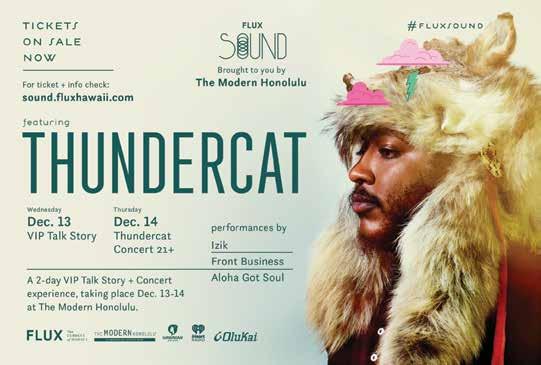

� Lynne Yamamoto, Borrowed Time , 2017
Repurposed wood, corrugated metal; Courtesy of the artist (L.2017-43.01)
© Lynne Yamamoto

� Edgar Heap of Birds
Selections from Dead Indian Stories , 2011
Left to right: TRY CARE DON’T INSULT THEIR BEAUTY (asking for respect towards indigenous spirits of past and present in light of offensive tourism and sports mascots)
HAPPY TO DONATE WHAT YOU TOOK
WILL GET ILL FROM STATIC BELIEFS (negative effects of Euro or American hierarchy religions)
MAKE DO WITH LESS THAN WORST (poverty in indigenous communities, world wide)
Ink on rag paper; 22 x 15 in. each Purchase, 2016 (2016-31-01-04)
© Edgar Heap of Birds
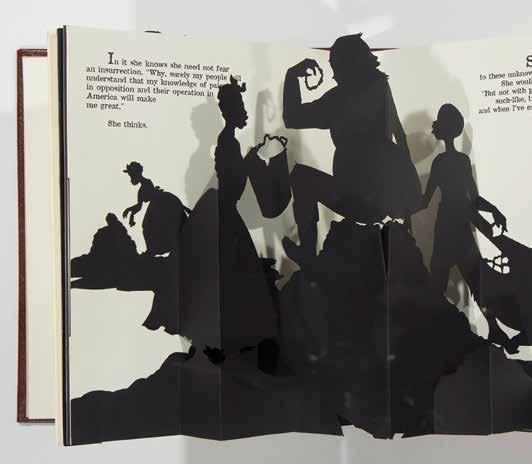
residential houses from a point in the past, when young residents could afford to buy homes in Honolulu. (Today, the average price for such a purchase is $760,000.) Lynne Yamamoto’s Borrowed Time was first installed at Foster Botanical Garden, a public county park filled with rare flora, during the inaugural Honolulu Biennial in the spring of 2017. The piece is a miniaturized porch, like those of plantation homes built before the advent of air conditioning. Now that it is indoors, viewers are bereft of the aural experience of rain on the
installation’s corrugated tin roof, the sound of everyday living in Oceania. But the work remains open for two people to sit—a perfect place for a selfie in the midst of a crisis.
Credit must be given to the Honolulu Museum of Art for the prescience to utilize a moderate purchasing budget to collect works from controversial living artists. Most of the art in The World Reflected is from earlier iterations of current conflict, but it is contemporary in that it presents today’s lived politics. War, racism, xenophobia, displacement,
and the loss of identity have not gone out of style. When John Coplans was photographing and enlarging a fist against a black background, an American president was facing impeachment. When the homes that Lynne Yamamoto’s Borrowed Time references were being built, a cold war was exploding across the Pacific. These perennial issues are fleetingly distant at Spalding House, which is arguably the most idyllic and romantic setting in Honolulu. It is a beautiful place at which to view ugly truths.

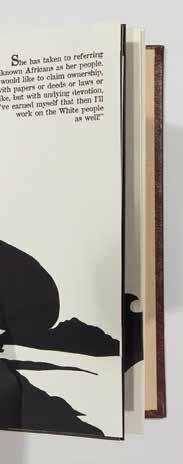
� Kara Walker, Freedom: a Fable: A Curious Interpretation of the Wit of a Negress in Troubled Times , 1997, paper, leather book. Gift of George and Nancy Ellis, 2012. © Kara Walker; image courtesy Sikkema Jenkins and Co.
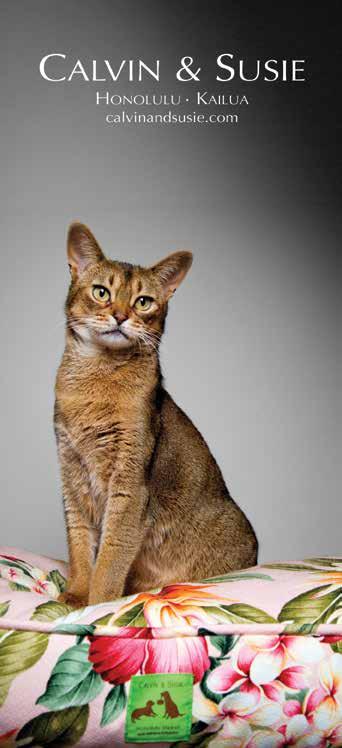

Kalapawai Market has been a neighborhood gathering place for Kailua and Lanikai residents since the early 1930s. This authentic country store offers everything from Oʻahu roasted coffee and gourmet deli sandwiches to accessories, craft beers, and anything you ʼ ll need to hit the beach.
Visit Kalapawai Cafe and Deli, at the entrance to Kailua Town, and now in the heart of Kapolei, for award winning bistro-style fare that focuses on clean, seasonal, and local flavors. Kalapawai Cafe always looks to buy from local farmers and ranchers first, whenever possible. They feature Boar’s Head premium deli meats for sandwiches, only the freshest dayboat fish, offer a unique fine wine and beer list, and serve coffee that is roasted down the street in Kapolei. The house-made gnocchi, Wagyu burger and daily fresh catch on lemongrass risotto can ʼ t be missed.
KALAPAWAI MARKET & DELI
At Kailua Beach 306 S. Kalaheo Ave. (808) 262-4359
KALAPAWAI CAFE & DELI
In Kailua Town 750 Kailua Rd. (808) 262-3354
In the heart of Kapolei 711 Kamokila Blvd. (808) 674-1700
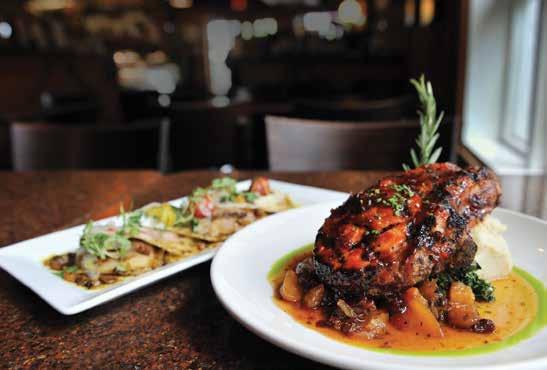

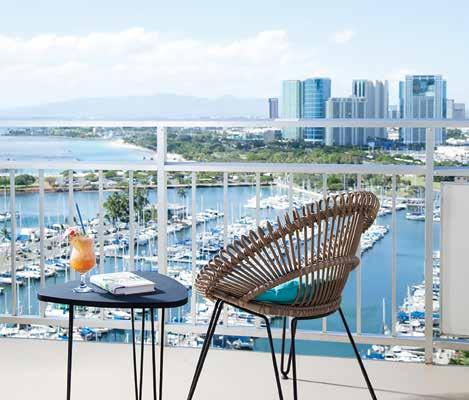
Spotted in Waikīkī: internationally recognized Ilikai Hotel and Luxury Suites, as featured in the opening shot of hit television show Hawaii Five- � . Be the leading star in your next picture-perfect staycation with a stay at this iconic symbol, which features luxurious suites that offer full kitchens with high-end touches, upscale furnishings, and stylish balconies with jaw-dropping views of the ocean and skyline.
Countless amenities will help fill your days off with fun under the sun. Hit the beach with custom towels and chairs available for daily use, arriving at the start of Waikīkī Beach following
an exclusive walkway. Delight in the flavors of Italy at Sarento’s at the Top of the Ilikai, and enjoy island dishes at Cinnamon’s at the Ilikai. Or jump on the daily shuttle for easy access to the rest of Waikīkī and Ala Moana for dining, shopping, and more. Secure your moment under the sun’s spotlight in paradise as soon as you can say, “Book ’em, Danno!” P.S. Don’t forget to sign up to be on the A-list for extra perks and benefits.
� For more information or to book a reservation, visit ilikaihotel.com or call 808-954-7417.




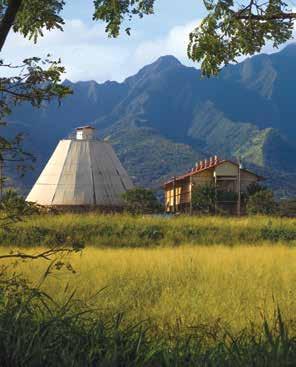




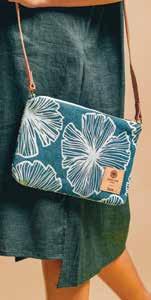

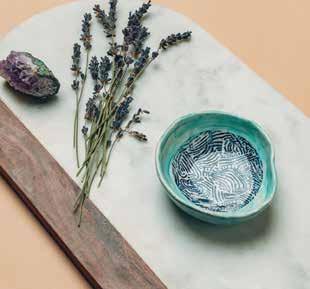


A long journey for a brief, unforgettable moment with the universe.TEXT BY MARTHA CHENG

We are all staring at the sun, but it is gone. In its place, there is only a black hole, encircled by a thin ring of bright white flame. It glows as intense as fire, but is as diaphanous as smoke suspended in the air.
The hole in the sky has made the world cold and dark, though the edges of the Earth, brushed in lavender and rose, cling to twilight. The stars closest to the sun come out, as if they, like the people below them, want to see what is happening.
The difference between a partial and total eclipse is literally the difference between light and dark; it is the difference between seeing the sliver of the sun from behind the dark lenses of eclipse glasses and seeing the brilliant corona with your naked eye. Millions of people have traveled into the path of totality, with large crowds gathering at parties resembling Burning Man. For months, Oregon cities were preparing as if for an emergency, advising residents to stock up on gas, food, and water, and warning of severe traffic jams.
Fear of gridlock, however, has made the traffic light. Where I am, in a park in Salem, Oregon, the vibe is mellow, like that of a group picnic with a few dozen families. Behind me is a couple from Portland, who were hula hooping to pass the time until the eclipse, and are now whooping as the last sliver of sun slides away. Nearby, the father of a family from Seattle, who was juggling until darkness hit, repeats over and over: “Sugoi! Sugoi! Sugoi!” like the rhythm of the balls rising and falling in the air.
I can only express myself in tears and gasping laughter. My mind, with no earthly spectacle to compare it to, flips through movies to try to comprehend what it sees. It lands
on Melancholia , with its depiction of the eerie, electrified landscape of the Earth before another planet crashes into it. I don’t dwell there, though, for joy and wonder crowd out fear.
Then, a brilliant flash of light ignites the upper edge of the blackness, like a J.J. Abrams lens flare multiplied by a million, or the dying sun rekindled in Sunshine . I want to stare forever, but totality is over. I grope for my dropped eclipse glasses to shield my eyes. I, who when faced with beauty am always waiting for its end, have forgotten that this too is finite. One minute and 55 seconds have passed, the shortest two minutes of my life. I know now why people chase eclipses. I have taken hallucinogens, I have traveled to see wonders of the world, and nothing has been so sublime and so heartbreakingly brief.
And yet it was a long journey, almost as wondrous as the eclipse itself. From Honolulu, I had flown to San Francisco to visit friends and family, then from the city caught a train, snagging the last seat from San Jose, California to Salem, Oregon, a 16-hour trip. The train was full of eclipse watchers who compared notes on how many total eclipses they’d seen, which town was better to watch it from, how they planned to capture the event, what music they would play as the sun disappeared from the sky. We passed through valleys bathed in the orange light of the sunrise. We glimpsed the snow-capped Mount Shasta as we hurtled north. Speeding along the track, we were like the moon moving in its orbit between the Earth and sun, all of us getting into place, to align for the briefest of moments.
